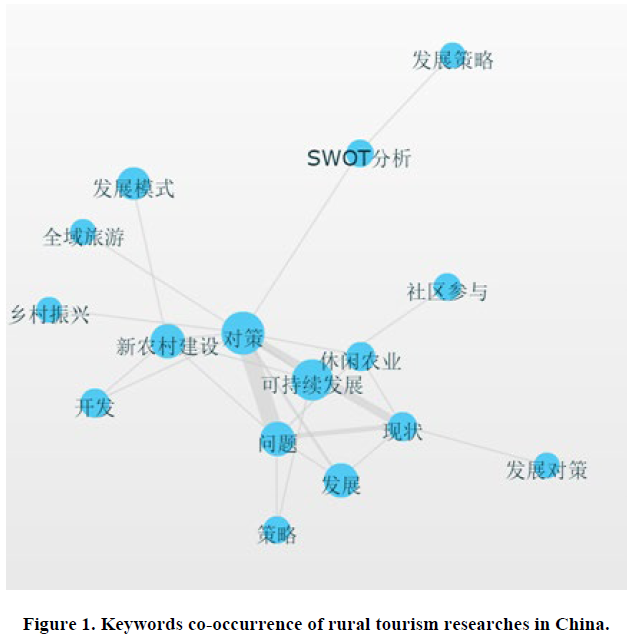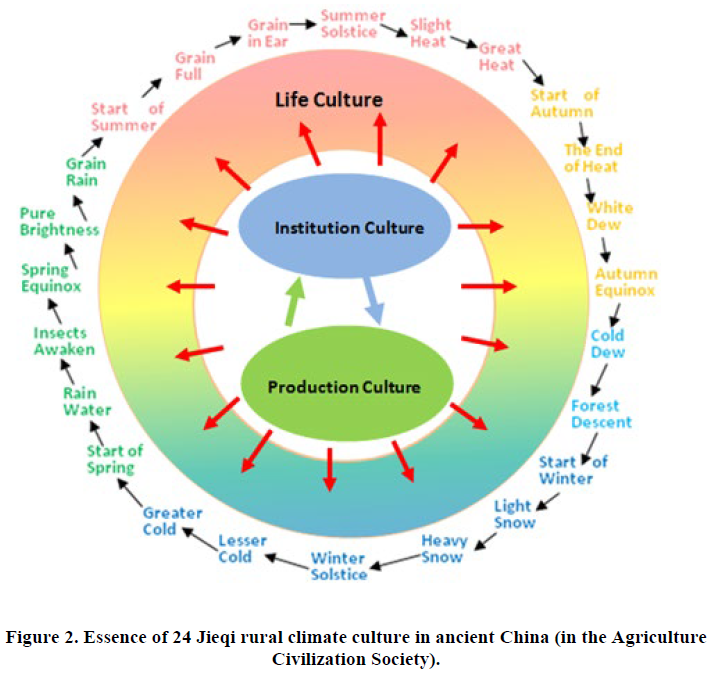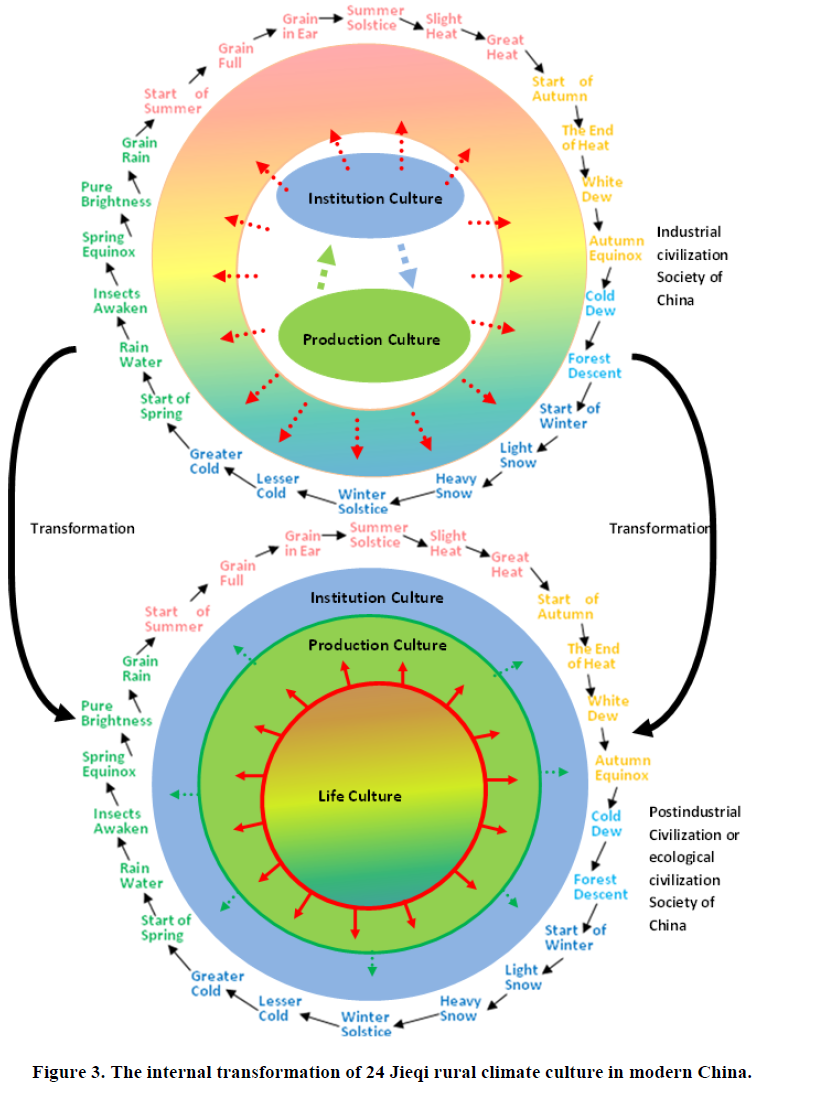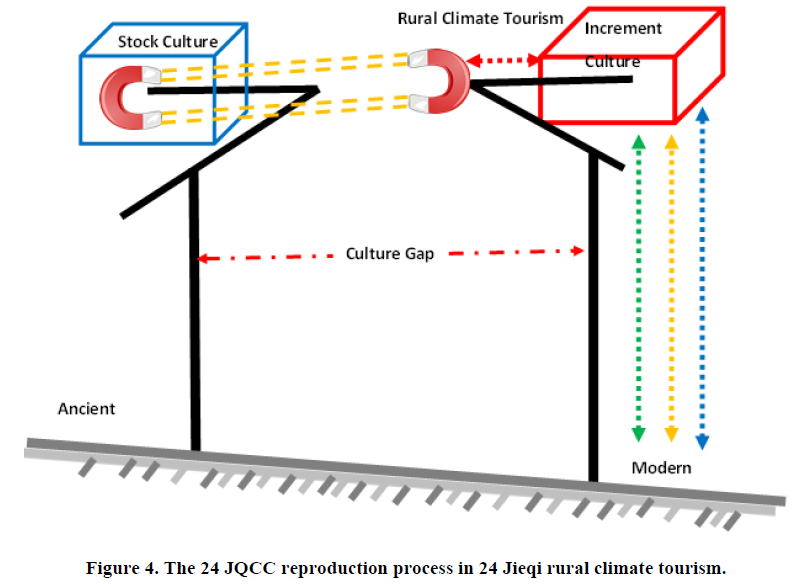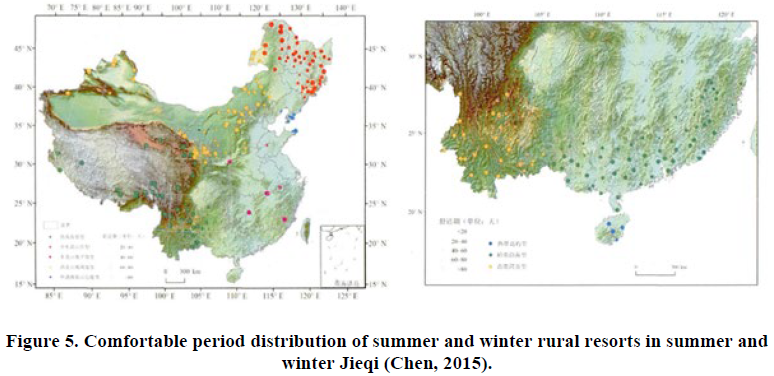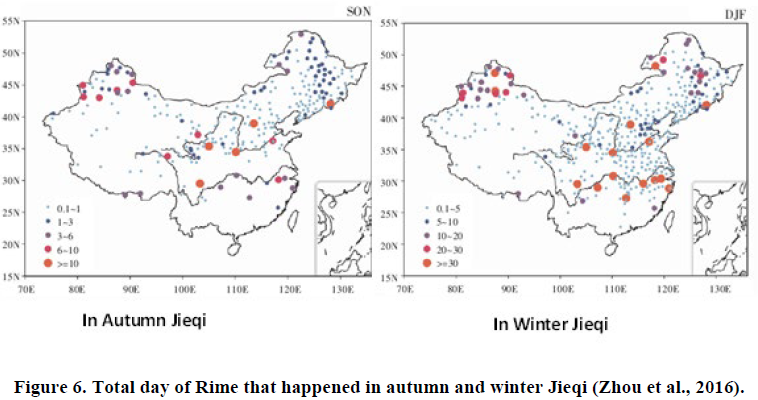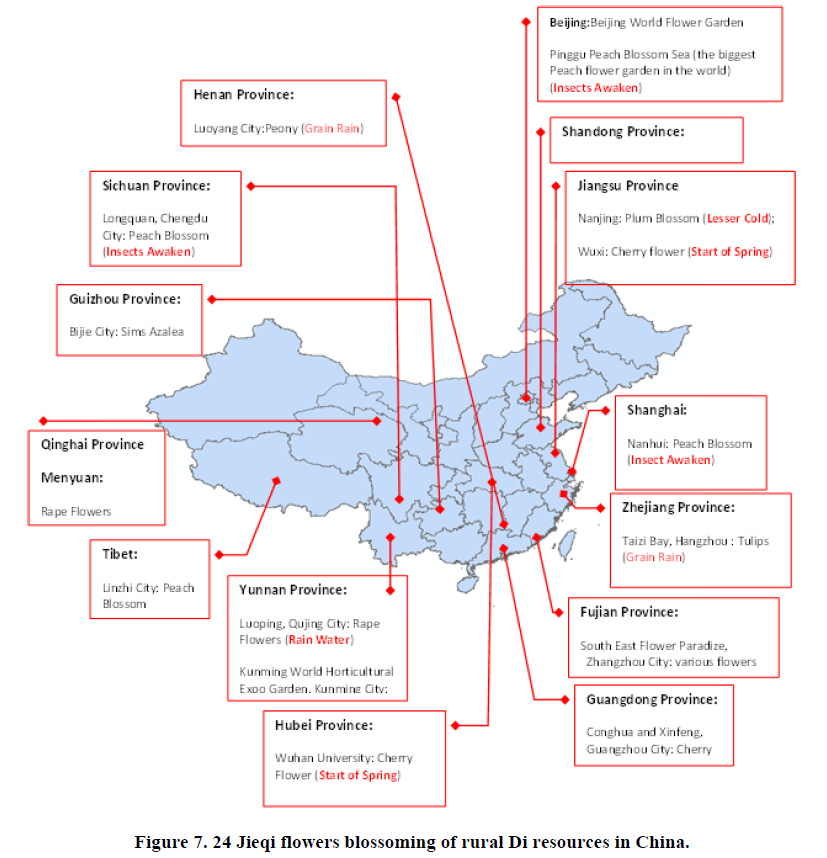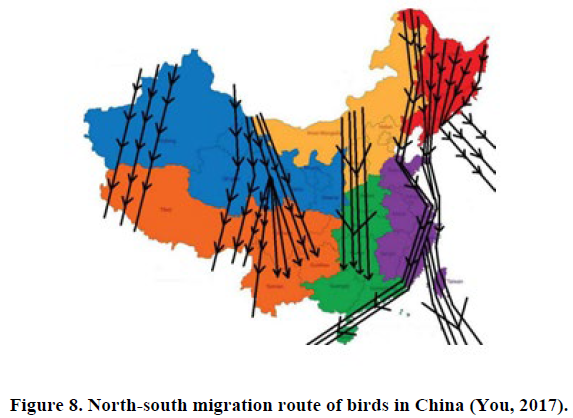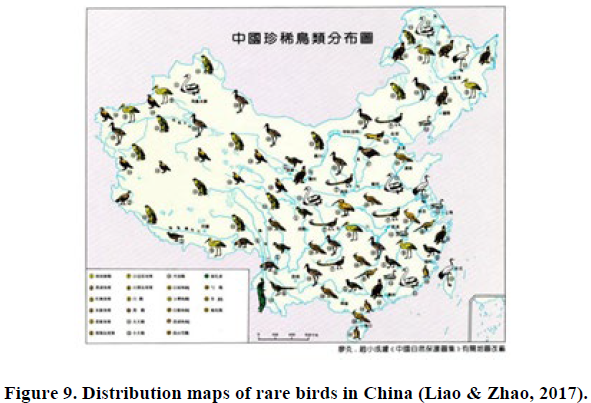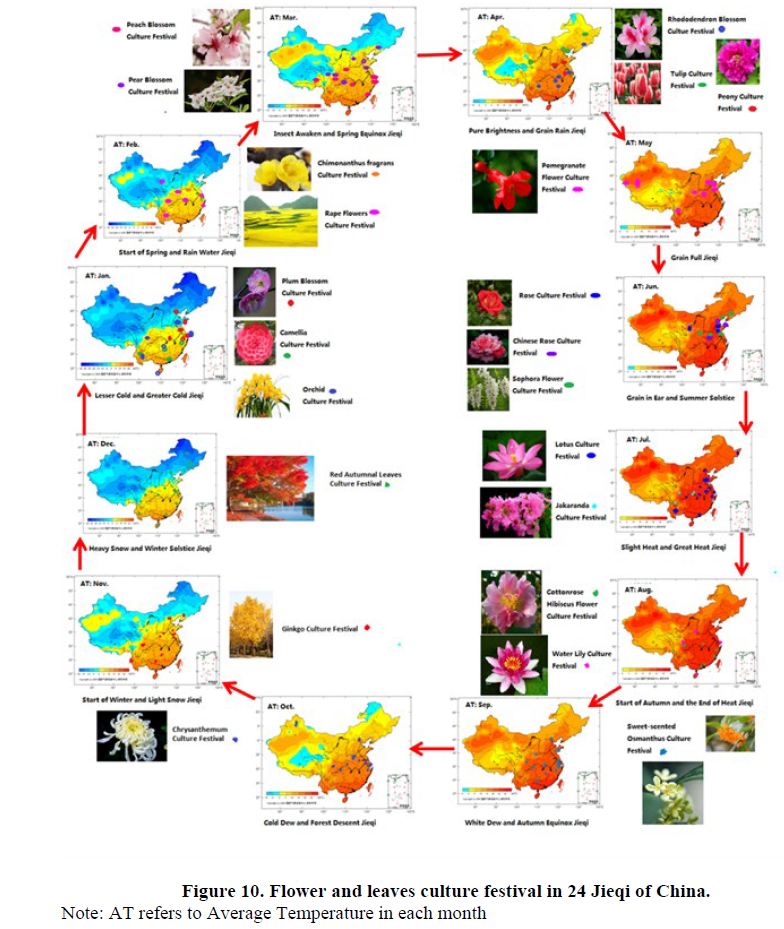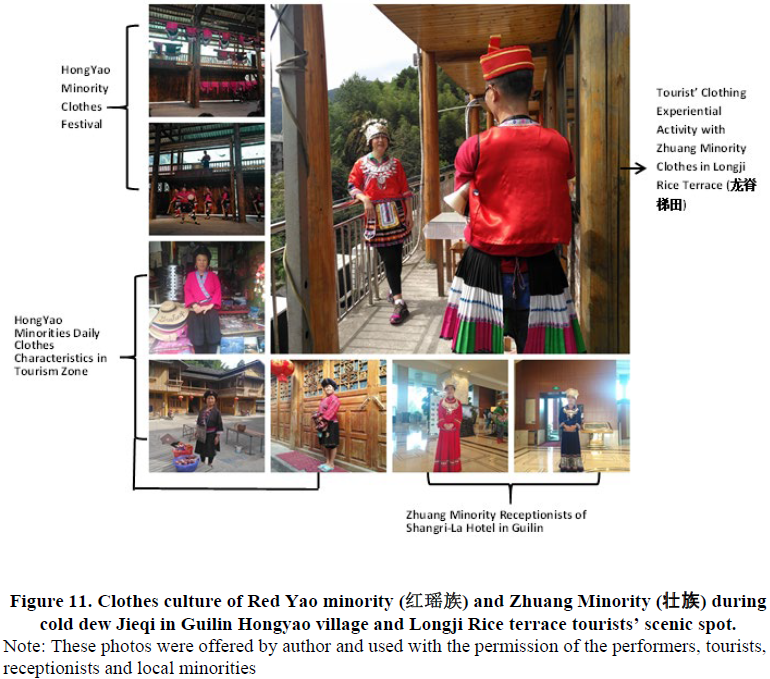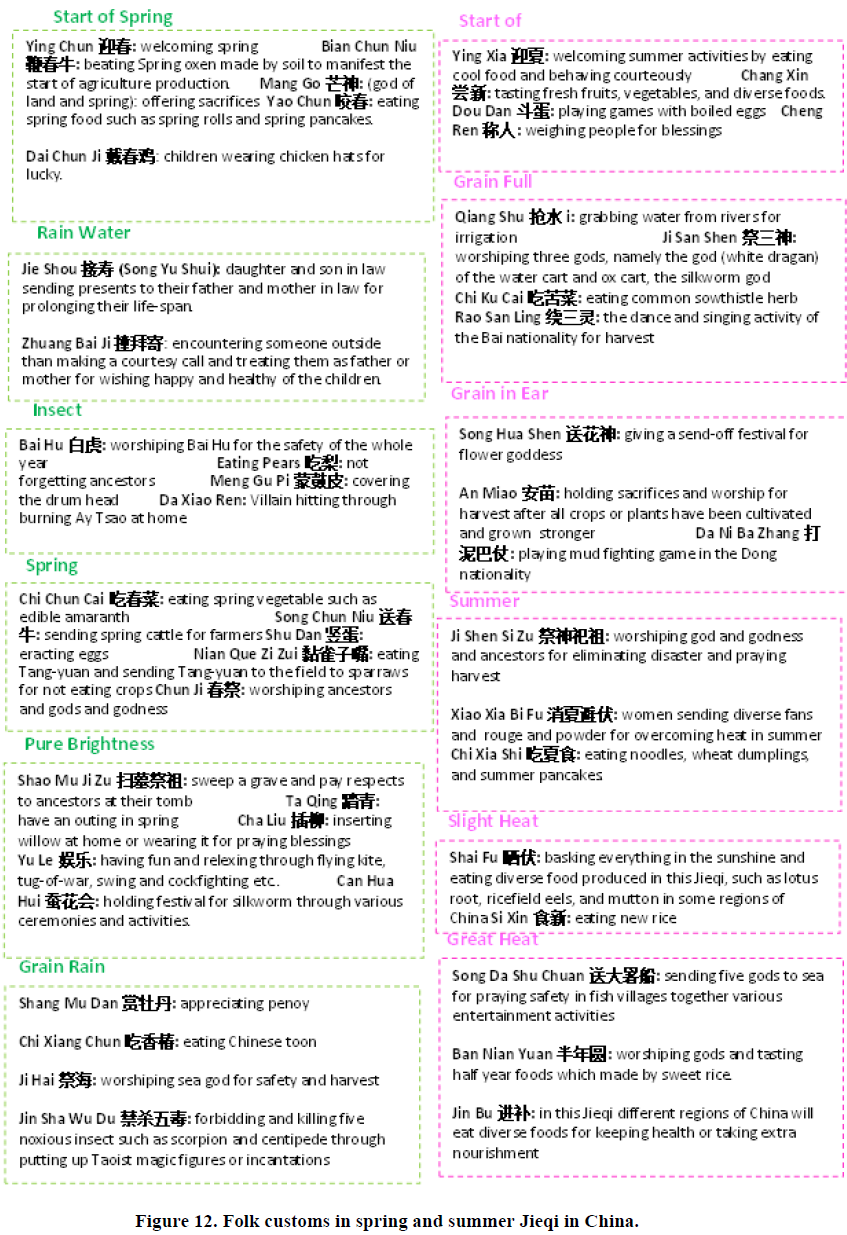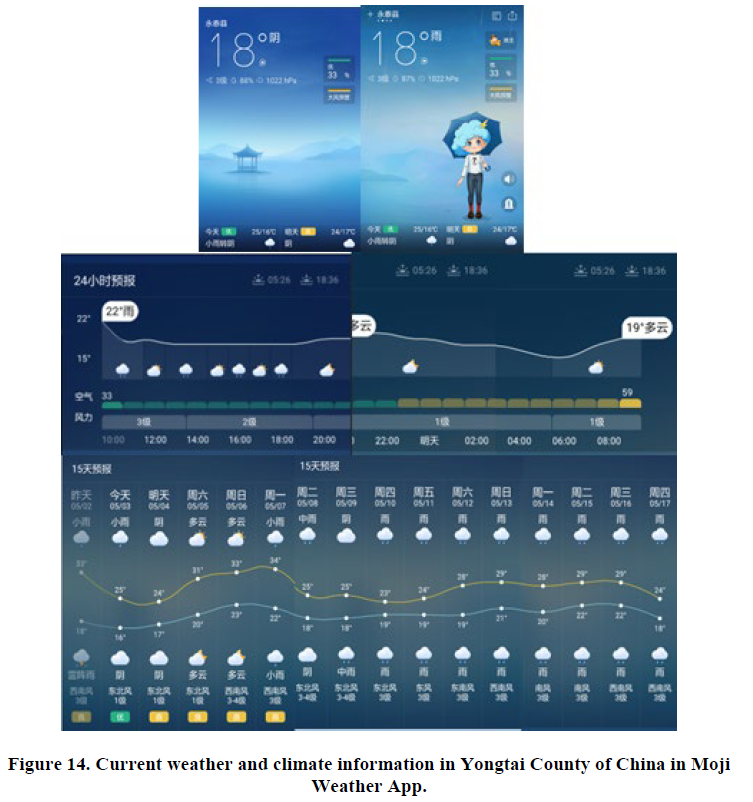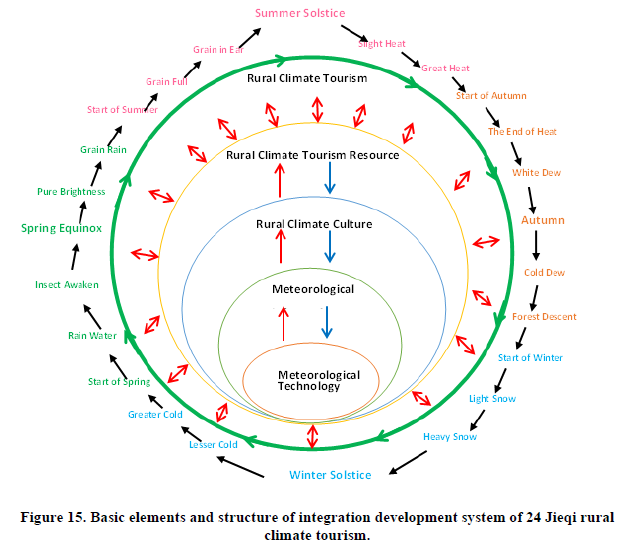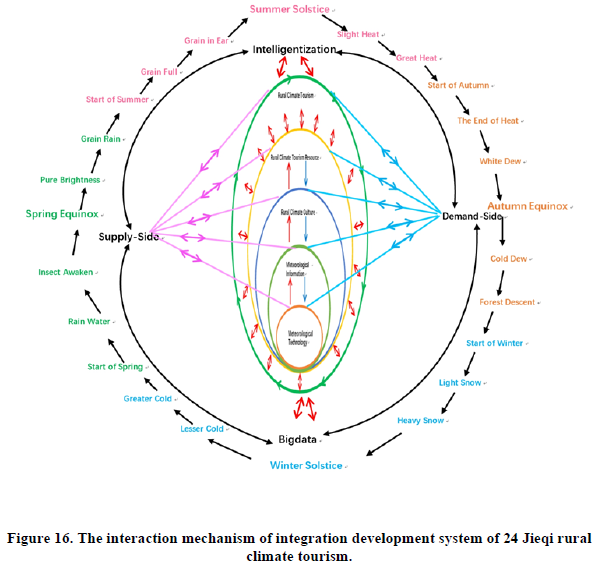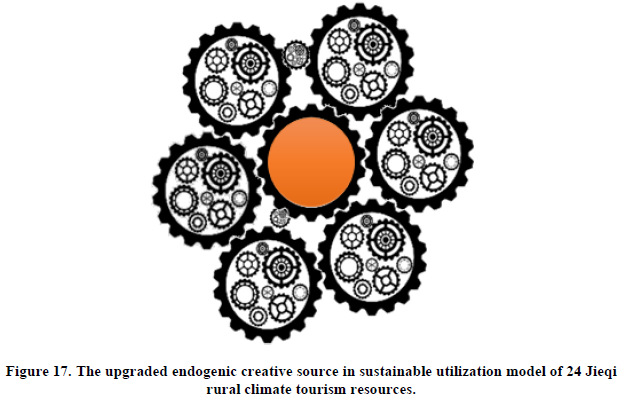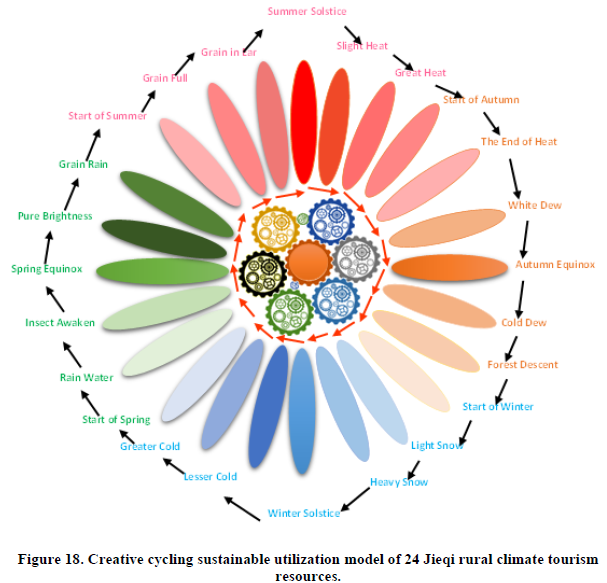| Xiaoyan Yang, Xiang Li |
| Corresponding Author: Xiang Li, Tourism College of Huaqiao University, China, China |
| Received: 12 March 2019; Revised: 20 April 2019; Accepted: 01 April 2019 |
| Share : |
1008
Views & Citations8
Likes & Shares
Keywords: 24 Jieqi, Rural Climate Tourism, 24 Jieqi Rural
Climate Culture, 24 Jieqi Rural Climate Tourism Resources, Integration
Development.
INTRODUCTION
24
Jieqi has successfully been listed as World Intangible Culture Heritage in 2016
and has achieved more and more attentions from government system, education
system, media system and diverse cultural researches in China.
However,
contemporary researches in China were not focus on rural tourism from climate
tourism perspective in rural areas and not systematically analyzed 24 Jieqi
climate tourism resources to explore sustainable utilization model in
contemporary China tourism market.
Therefore,
for 24 Jieqi Intangible Culture Heritage preservation and sustainable
development in rural areas, this paper firstly proposes 24 Jieqi rural climate
tourism in China context, explores 24 Jieqi rural climate culture
transformation mechanism in China and the 24 Jieqi rural climate tourism
resources that summarized into Tian, Di and Ren resources system, put forwards
Upgraded Endogenetic Creative Source as core of sustainable utilization of 24
Jieqi rural climate tourism resources and the creative cycling sustainable
utilization model of 24 Jieqi rural climate tourism resources in modern China
tourism market.
METHODOLOGY
Based
on combination method of literature review that summarized by this paper
utilise meta-analytic review method, argument based review and systematic
review all together to analyse 24 Jieqi, rural climate tourism and there
integration in China tourism market, which also promote in-depth exploration
that proposed in this paper for Jieqi rural climate tourism sustainable
development pattern. Based on China Knowledge Resource Integrated Database (CNKID)
(http://www.cnki.net),
this paper search contemporary research of 24 Jieqi, rural tourism by entering
“er shi si jie qi” and “xiang cun lv you” into keywords, title and subject as
searching contemporary research of 24 Jieqi and rural tourism in China. There
are about 358 articles of 24 Jieqi (http://kns.cnki.net/kns/brief/result.aspx?dbprefix=SCDB&crossDbcodes=CJFQ,CDFD,CMFD,CPFD,IPFD,CCND,CCJD) from 01/01/1975 to
26/03/2019. Meanwhile, there are about 8203 articles of rural tourism in China
(http://kns.cnki.net/kns/brief/result.aspx?dbprefix=SCDB&crossDbcodes=CJFQ,CDFD,CMFD,CPFD,IPFD,CCND,CCJD) from 01/01/1992 to 26/03/2019. The
keywords co-occurrence networks naturally generated by visualization analysis
function of CNKID.
LITERATURE
REVIEW
Jieqi Research in China
Contemporary
in China, the researches of 24 Jieqi are mainly distributed in disciplines of
Ethnology, Traditional Chinese Medicine, Agriculture resources and environment,
Astronomy, Atmospheric science, Culturology, Folklore, Arts, Literature and
Education, etc., to analyse 24 Jieqi from their discipline perspective. Natural
science primarily focus on the natural climate characteristics of 24 Jieqi and
its dynamic climate change rules in different regions of China, such as the
temperature and precipitation analysis (Liang & Wu, 2018), climate change
(Qian et al., 2018; Qian et al., 2011), spatial distribution of energy
resources (Dong et al., 2017) and climate adaptation (Yangjiciren, 2014) of 24
Jieqi in specific region. Meanwhile, the researches of 24 Jieqi in natural
science are mainly in disciplines of Traditional Chinese medicines and
integrated traditional Chinese and Western medicine. The natural climate
features of 24 Jieqi have relationship with diverse diseases as well as their
mechanism in different Jieqi, which emphasize to obey dynamic features of 24
Jieqi climate conditions in specific regions of China to keep wealth and
actively adapt to the climate characteristics to protect people from diverse
disease through 24 Jieqi food therapy, medicine treatment, combination of
different types of wellness preservation (Deng, 2016; Ma, 2013; Shi, 2011;
Zheng & Zhao, 2016). Therefore, natural science primarily focuses on the
natural features of 24 Jieqi climate conditions and its dynamic fluctuation
rules as well as its relationship with human health.
After
24 Jieqi have been listed into intangible cultural heritage of UNESSCO, most
social science have gradually noticed its values in society and try to explore
the formation and development of 24 Jieqi in China (Liu, 2017; Shen, 2001), its
essences as part of traditional Chinese culture (Cui, 2009; Shang & Zhou,
2015), its preservation and current inheriting situation in China (Wang, 2017;
Zhou, 2015a). 24 Jieqi have been discussed by culture and culturology and
folklore perspective to analyse the aesthetic culture of 24 Jieqi (Reng, 2017),
different folklore in different regions of China at the same Jieqi or in
different Jieqi respectively (Wang, 2017; Xiao, 2015; Zhou, 2015b). In some
application disciplines such as visual design focus on 24 Jieqi cultural visual
design, creative Jieqi cultural products design, 24 Jieqi color image design as
well as visual happiness in different Jieqi and so forth (Jin, 2017; Wang,
2018; Yang & Jiang, 2018; Zhu, 2017). It also have been utilised in
landscapes and architecture discipline to discuss 24 Jieqi landscapes
expression, landscapes design and landscapes atmosphere creation and
organization (Chen, 2018; Wang & Li, 2018; Xu et al., 2017). For
sustainable protection and inheritance of 24 Jieqi, the education system have
actively integrated it into daily curriculum for providing students
opportunities to learning 24 Jieqi climate wisdom of China and try to
experience nature by perceiving them in daily life (Wang, 2011; Wu, 2018).
Therefore, social science are mainly focus on the cultural and social essences
of 24 Jieqi as well as its values as traditional Chinese culture that
experienced and inherited by Chinese from one generation to another. 24 Jieqi
generated from agriculture civilization of ancient China and hand down by
Chines, which are now seldom to be noticed a vital resources that could be
utilized in rural tourism in China.
Rural Tourism Research in China
JIEQI RURAL
CLIMATE CULTURE TRANSFORMATION IN CHINA
To understand the origin and
evolution of 24 Jieqi rural climate culture, abbreviated as 24 JQRCC. The
production, institution and life culture of 24 JQRCC are proposed in this
research to systematically analyze the historical development and regeneration
of 24 JQRCC in a new era of Chinese society. For 24 Jieqi generated and
constructed by ancient Chinese for accurately estimating dynamic climate
changes in each Jieqi and guiding agriculture production, which naturally
formed the production culture of 24 JQRCC. As an agriculture civilization
society of ancient China, proper institutions and rules had been built and
enacted to support and regulate daily operation of agriculture production which
is the main economy industry in ancient China and also the key revenue of
government so that institution culture of 24 Jieqi had been constructed and
handed down from one generation to another in ancient China. Consequently, the
development and boom of production and institution culture of 24 JQRCC
naturally permeated directly into daily life of ancient Chinese and influenced
their life arrangement and dynamic behaviors changes according to the natural
and cultural influence of 24 Jieqi in ancient Chinese society (Wo, 2017)
(Figure 2).
Given the dynamic social changes from ancient to modern China, the 24 JQRCC transformed as the tourism industry of China dramatically developed. An in-depth exploration of climate tourism followed the tendency of experience and existential tourism practices. Products and services were designed to meet the demands of tourists relative to the active reactions of industries and the appropriate adjustments that follow this tendency. Therefore, the 24 JQRCC transformed internally in structure and interaction relationship of basic elements, catalyzed by rural climate tourism development through 24 Jieqi rural climate culture resources’ efficient utilization in rural climate tourism market and adapted to tourism development trend of China society.
Internal Transformation of 24 JQRCC
In ancient China, the production
culture of 24 JQRCC focused on agricultural production for human survival. The
institution culture of 24 Jieqi was established and inherited from one dynasty
to another to promote political stability (Li, 2010). These cultures were
integrated into the daily life of the ancient Chinese and gradually formed the
life culture of 24 Jieqi. Therefore, in this period, the production,
institution and life culture of 24 Jieqi accelerated the development of
agricultural civilization. Thus, this stage can be regarded as the development
stage of the 24 JQRCC. However, when China became the Republic of China and
during the Reform and Opening-up of the People’s Republic of China, the main
production patterns of society shifted from agriculture to manufacturing
industry. The manufacturing industry was less influenced by the climate
conditions of specific regions. Hence, the production culture of 24 JQRCC
shrank and the institution culture of 24 Jieqi was abolished. Political
environments and institutions changed dramatically, whereas the life culture of
24 Jieqi was gradually ignored and disappeared although it changed slower than
the production and institution culture of 24 Jieqi (Li, 2005; Zhang, 2010; Xu,
2010). This stage can be recognized as the stagnation stage of 24 JQRCC (Figure
3).
The interactions among the
production, institution and life culture of 24 JQRCC in different social
contexts transformed the 24 JQRCC. The New Normal Situation Stage of the
People’s Republic of China (Shi & Zhang, 2015; Jin, 2015) significantly
differed from ancient China and the Republic of China (1912-1949). During the
New Normal Situation Stage, modern China is dominated by the life culture of 24
Jieqi which have been noticed and needed by Chinese in daily life as economy
prosperous and culture revitalization in China society. This trend has further
affected production culture of China from focusing on first and second industry
into service industry, especially the booming of rural climate tourism and has
emphasized and oriented toward local people or tourists’ need to produce rural
climate tourism products or services rather than agriculture production
efficiency so the production culture of 24 JQRCC have changed dramatically and
its resources scopes have enlarged from not only focusing on natural climate
resource of 24 Jieqi but also cultural resource of 24 Jieqi to creatively
produce rural climate tourism products and services (Figure 3).
Influenced and triggered by life
and production culture transformation of 24 JQRCC, the institution culture of
24 JQRCC in tourism fields has also changed. The particular institutions of 24
Jieqi astronomy and calendar, agriculture institutions for agriculture
production in different Jieqi and the etiquette institutions in particular
Jieqi of ancient China have become intangible heritage resources in rural
climate tourism in each Jieqi, attracting tourists and local residents.
In addition, the institution of 24 JQRCC will
influence the holiday and leisure institution of China gradually improved in
the future, which will not only adapt to the flexible holiday institution
demand of Chinese in modern China and further offset disadvantages of
contemporary holiday institution in China (Cai, 2014; Dong & Zhang, 2015;
Zhang, 2015) but also promote the 24 Jieqi rural climate tourism development
through 24 Jieqi life culture resources utilization, integration and
reproduction in 24 Jieqi holiday as well as the production efficiency
improvement in rural climate tourism market in each Jieqi (Wei, 2017).
The function of 24 Jieqi holiday institution or
holiday choice is guiding social behavior of Chinese to experience leisure and
enrich their body and soul through diverse holiday activities, accelerating
social economy development by stimulating holiday consumption in local leisure
activity and tourism activity and also promoting tourism industry and related
industry development through supply proper products and services for tourists
and people seeking leisure life (Zhang et al., 2014; Zhang, 2015; Wu, 2017).
Flexible holiday choices Institution of 24 Jieqi could
be arranged and permeated into contemporary holiday institution of China when
considering more connection between 24 Jieqi holidays with paid holiday
institutions. The more advancement of paid holidays within 24 Jieqi will become
a win-win choices for more flexibility and individualization of tourists, for
tourists destination development and dynamic management within 24 Jieqi, for
tourist attractions creations and design obeying the natural and cultural rules
of 24 Jieqi within China society, for the harmonious connection and interaction
of life culture, production culture and holiday institution culture of 24 Jieqi
in climate tourism of contemporary China, which will naturally and profoundly
influence 24 JQRCC reproduction and regeneration in rural climate tourism
practices.
Therefore, the internal structure transformation of
24 JQRCC have been occurred in China society and will more deeply explored,
interacted and promoted in rural climate tourism practices. Additionally,
social division of labor changed significantly. The deeper the division of
society, the more the Chinese are emancipated from the first and second
industries and participated in the service industry (Jin, 2015), especially the
tourism industry in New Normal Situation Stage of the People’s Republic of
China (Xu, 2010). The 24 JQRCC has an opportunity to regenerated and recreated
in rural climate tourism of China and further accelerate the internal
transformation, interaction and upgrading when more and more tourists
influenced by 24 Jieqi climate culture in China society permeated through
education system and media system as well as the governmental promotion (Liao &
Li, 2016; Ma, 2018; Luo, 2018).
Interaction
Mechanism of Stock and Increment 24JQRCC in Rural Climate Tourism
From ancient to modern China, the stock and
increment culture of 24 Jieqi exist and interact with each other through rural
climate tourism practices. These cultures serve as resources for further
exploration and creation of particular products or services to meet tourist
demands in modern China.
The stock culture of 24 JQRCC refers to the culture
that appeared in ancient China regardless of the material or mental patterns it
displayed (Xu & Chen, 2015). These patterns accounted for 5000 years of
history of ancient China. More Precisely, the stock culture of 24 Jieqi include
the ancient production culture of 24 JQRCC (Long, 2017; Mahamuti, 2017) such as
seeding cultivation in Start of Spring, crops planting in Insect Awaken,
fertilizing and weeding in Spring Equinox, pest controlling in Grain Rain and
so forth summarized by ancient Chinese (the time sequence and particular
agriculture production process will a little bit different in each Jieqi in
China for the large territory and diverse climate zones in each part of China)
(Zhao & Zhang, 2004; Hu, 2007; Ma, 2009; Wang, 2012; Zhang & Cao,
2015); the ancient institution culture of 24 JQRCC (Chen, 2017) such as the
astronomy institutions in each dynasty of ancient China, the agriculture
institutions in each Jieqi for guiding farmer’s behaviors in each agriculture
production process, the etiquette institution in each Jieqi performed from
empire to normal ancient Chinese in different dynasties etc. (Chen, 1995; Ge,
2001; Song, 2006; Gao, 2010; Li & Chen, 2010; Zhao, 2015); the ancient life
culture of 24 JQRCC (Reng, 2017) such as art culture of 24 Jieqi (various
folk-customs, traditional Chinese literature of 24 Jieqi, Chinese paintings,
calligraphy, embroidery, paper-cut of 24 Jieqi, etc.) (Xiao, 2015; Wang, 2017),
living environment culture in different Jieqi and different climate region of
China (Zhou & Liu, 1999; Zhang et al., 2015; Hu, 2016), clothes culture
(symbolic reflection of 24 Jieqi phenological phenomena of local creatures and
particular style patterns for adapting local dynamic climate changes in
different Jieqi) (Feng, 2002; Ai, 2004; Cui, 2014; Na, 2014; Shao, 2017),
traditional Chinese medicine culture and food therapy culture of 24 Jieqi and
so forth.
The increment culture of 24 JQRCC refers to the
culture that will be created and regenerated in the 24 Jieqi of daily life,
which were nourished and enriched by the stock culture of 24 Jieqi in different
dynasties of ancient China and extensively facilitated by modern advancements.
For instance, rooted in the stock culture of 24 Jieqi, more and more increment
culture of 24 Jieqi has been created or redeveloped such as the creation of 24
Jieqi picture books for children (Zhan, 2017), new exploration of 24 Jieqi
landscapes expression (Xu et al., 2017), the creative exploration of 24 Jieqi
cultural documentary (Dong, 2017), the visual conversion of 24 Jieqi culture
(Xiao, 2017) and so forth. In terms of rural climate tourism practice, the
increment culture of 24 JQRCC is created and newly explored by tourists,
tourism companies or tourism managers in particular tourist destinations in
different Jieqi and all aspects of rural climate tourism activities or
processes. For example, the new tourist attractions creation in different Jieqi
such as 24 Jieqi folk-customs (Zhou, 2015), 24 Jieqi art exhibition (Yuan,
2015), 24 Jieqi B&B Hotel products and services, etc. In addition, this
culture will be promoted and flourished by means of science and technology
achievements in information facilities, transportation infrastructures, GIS
applications and so forth. Hence, the increment culture of 24 JQRCC in climate
tourism process is the product of cultural reproduction. Increment culture
involves stock culture and bridges the cultural gap of 24 JQRCC between ancient
and modern China through active interactions in the cultural reproduction
process (Figure 4).
Moreover, the increment culture of 24 Jieqi in
climate tourism practices require supply-side (particular destinations, tourist
attractions and natural or cultural landscapes), demand-side (tourist
preferences, structures, scales, payment capacity and backgrounds in a
particular society) and intermediate or correlate industries (transportation
system, information system, market and online agents) to react and interact
with each other quickly and actively from life, institution and production
culture of 24 JQRCC in modern China through rural climate tourism practices in
society. Consequently, influenced by modern society’s characteristics, the
increment culture of 24 Jieqi will lead to diverse and abundant elements that
differ from those of ancient times. These elements will better fit and satisfy
modern tourists’ preferences and deepen culture communications through 24 JQRCC
explorations.
The stock and increment culture of 24 JQRCC interact
with each other in rural climate tourism practices, especially as China
entering into deeply exploration of supply-side revolution in tourism industry.
Enriched and nourished by stock culture accumulated from ancient time, modern
China embraced the abundant treasures of 24 JQRCC in diverse forms, such as
materials, mental experiences or knowledge, institutions and behaviors. This
stock culture could be re-utilized and re-produced through modern Chinese’s
active participation and recreation. To better appreciate the stock culture of
24 Jieqi, its increment culture could be catalyzed by rural climate tourism
practices through enforcement such as an in-depth excavation of life culture of
24 Jieqi handed down from ancient China to develop new products and services
for rural climate tourism, which also cater to the demands of contemporary
tourists (Figure 4).
24 Jieqi rural climate tourism is vital for the
reproduction of 24 JQRCC. 24 Jieqi rural climate tourism preserves the
philosophical essence of 24 JQRCC but also embraces various and diverse
patterns of particular climate cultures in different Jieqi for in-depth
development in rural climate tourism planning, management, marketing, products
and service redesigning and tourist destination and tourist attractions
upgrading through exploring 24 Jieqi or particular Jieqi. This development
meets tourist needs and significantly supports culture reproduction and
practice system rather than the use of shallow conception that lack life
essences. Meanwhile, the annual and seasonal progress of each Jieqi is a
natural climate cultural exhibition in China from the North to the South and
from the East to West. Tourists could
allow the experience of local climate culture and immerse into the local social
pace of life, production and institution culture of 24 Jieqi to constructively
support their fulfillment from external to internal needs, satisfying tourists
in each Jieqi.
JIEQI
RURAL CLIMATE TOURISM IN CHINA
Essences
of 24 Jieqi Rural Climate Tourism in China
Climate tourism practices are obvious and popular in
China all the time and still increasingly appear upward tendency in
contemporary China tourism market (Lin et al., 2013; Yan, 2014). Under vigorous
demand background of climate tourism in China, the climate tourism products and
services have appeared diversity, such as traditional winter tourism (Wang,
2009; Liu, 2013; Yang et al., 2017), the summer tourism (Wang & Zhang,
2006; Dong & Chen, 2016; Zhao, 2017), winter resort tourism and summer
resort tourism (Wu, 2010; Luo, 2010); cultural climate health preserving
tourism (Ruan, 2014; Mao, 2017) and Jieqi culture tourism (Gao et al., 2017;
Zhang & Deng, 2017; Huang, 2017); ecological phenology tourism such as bird
seeing tourism (Wang, 2008; Li, 2013; Lin, 2017), flower tourism (Tang, 2007;
Zhang, 2015; Li, 2016), colorful leaves tourism (Gao, 2015; Lv & Jiang,
2015; Yan et al., 2016; Fang & He, 2016) and meteorological landscape
tourism, etc.
Yang (2018) proposed that climate tourism refers to
a comprehensive tourism activity that attracts tourists to experience natural
climate conditions, as well as the climate adaptation culture of human beings
in certain regions of societies; this activity is organized and managed by the
tourism industry to satisfy various tourists’ needs in diverse forms, such as
meteorological sightings, climate phenomena, leisure and vocation in certain
climate resorts in the summer or winter and exploration and learning activities
of climate folk customs (Yang, 2018). In China context, 24 Jieqi is pivotal
climate knowledge system handed down from ancient time and embrace various and
diverse cultural treasures of Chinese life adapting to local climate conditions
in different Jieqi. Therefore, 24 Jieqi climate tourism also has been proposed
for further exploring China climate tourism from theoretical and practical
perspective (Yang, 2018). In climate tourism, the tourist attraction of climate
resource includes not only the aforementioned natural climate resources but
also the humanity climate adaptation landscapes (namely, cultural climate
resources), which embrace materials, behaviors, institutions and mental wealth
created by humans for adapting to climate conditions around them (Yang, 2018).
The natural and cultural phenomena of 24 Jieqi
generated and flourished in rural areas since ancient China so that it is
naturally and unavoidably to propose 24 Jieqi rural climate tourism in China
rural tourism development context. From concept perspective, rural tourism had
been proposed and discussed thoroughly by researchers. For instance, He &
Li (2002) summarized that from narrow sense rural tourism is the tourism
activities that organized through treating natural and cultural objects with
rurality features as tourist attractions in rural areas (He & Li, 2002).
Liu (2006) indicated that rural tourism is the tourism activities that attracts
tourists to relaxing, sightseeing, experiencing, learning and so forth through
tourist attractions of rural customs and practices composed by rural geography,
rural materials and scenery, rural customs, rural landscapes and particular
phenomena in rural areas (Liu, 2006). From resource and function perspectives,
Li & Zhang (2018) argued that rural tourism is the newly development
patterns of agriculture sightseeing and experience tourism and the rural
leisure vocation tourism that attracts tourists through tourists attractions of
rural nature environment, rural scenery, settlement building landscapes, rural
customs culture; aims for rural sightseeing, rural leisure, rural custom
experiencing and rural vocation; depends on supporting of agriculture
production, agriculture landscapes, farmer’ life and so forth (Li & Zhang,
2018).
Considering the development and drastic
transformation of China economy and society, rural tourism faced deeper
exploration for satisfying tourists’ diverse demand and flourishing rural
tourism market in particular rural areas. Therefore, from 24 Jieqi climate
tourism perspectives, it is worthwhile to explore 24 Jieqi rural climate
tourism which embrace traditional rural tourism characteristics summarized by
researchers mentioned above like rurality and happen in rural areas. Apart from
that, 24 Jieqi rural climate tourism focus mostly on the natural and cultural
climate tourism resources in each Jieqi to create, establish, organize or
manage particular natural, cultural or compounded 24 Jieqi tourist attractions
for tourists to experience various rural climate tourism activities. Inspired
by 24 jieqi wisdom of ancient Chinese and interacted with harmonious modern
life wisdom in each Jieqi, 24 Jieqi rural climate tourism attempt to guide
tourists, tourism suppliers to deepen their perception and creative experience
in each Jieqi and harmoniously follow the natural rules to organize their life and
operations in 24 Jieqi rural tourism activities. The wisdom of 24 Jieqi reveal
change is core of life that need adapting to it with creative mind and
sensitive soul, which embrace relative stable for everything accumulating and
growing gradually. That means 24 Jieqi rural climate tourism welcome the
changes of local climate conditions, the changes phenological phenomena of
plants, animals and human beings, the changes of social customs for enriching
leisure life and so forth; and also enjoy the relative stable process to slow
down and appreciate beautiful life.
In addition, for new tendency of active and constant
interactions between rural and urban in China, more and more qualified and
talented personnel will flux back or flux into rural areas, which will become
precious treasures for 24 Jieqi rural climate tourism development because of
deeper understanding of life and creative exploration of 24 Jieqi climate
tourism resources in rural areas with talented inspiration and artistic
appreciation as well as new accumulation and gathering of talent people into
rural areas with diverse education background to harmoniously melt into rural
areas and open new era of 24 Jieqi rural climate tourism in modern China,
corresponding to 24 Jieqi rural climate culture transformation trend (Huang,
2017).
Jieqi
Rural Climate Tourism Resources in China Tourism Market
To deeper pursuing sustainable development of 24
Jieqi rural climate tourism in China, it is indispensable to explore the 24
Jieqi Rural Climate Tourism Resources. In China’s context, the 24 Jieqi is
pivotal rural climate tourism resources from natural and cultural aspects that
cannot be ignored. Meanwhile, within 24 Jieqi, various natural rural climate
tourism resources from Tian and Di or their combination phenomena occurred in
particular climate region and geographical location. Furthermore, cultural
climate tourism resources can be summarized as an output of Ren when
interacting with Tian and Di in certain society with different levels of
civilization. Therefore, the 24 Jieqi rural climate tourism resources can be
classified and gathered into Tian, Di and Ren aspects inspired by ancient
wisdom of China. Moreover, the relativity and features of comparative advantage
of 24 Jieqi rural climate tourism resources should be emphasized in a more open
and high mobility rural climate tourism market of China.
Jieqi
rural climate tourism resource — 24 Jieqi rural Tian resource
24 Jieqi Tian resources refer to dynamic climate condition changes in different Jieqi in particular rural areas or diverse climate conditions of different rural areas in each Jieqi, as well as specific climatic and meteorological phenomena that attract tourists’ attentions or become tourist attractions could be utilized and deeper developed as particular rural climate tourism products or services organized within various rural climate tourism activities.
For climate conditions changes gradually within 24 Jieqi cycle, particular rural areas experience slight differences of climate conditions from one Jieqi to another, which become important tourist attraction factor that influence tourists’ rural climate comfortable feelings as well as excite tourists who never experience before, becoming pivotal rural climate tourism resources for rural climate tourism development. From a broader perspective, for China territory embraces diverse climate zones from north to south and from east to west, at the same Jieqi different rural areas of China have appeared diverse climate conditions, which has become relative resources for rural climate tourism in particular rural areas have more comfortable climate conditions and enable them to accelerate those comparative advantages to supply specific rural climate tourism products and services (Figure 5).
In summer Jieqi, such as slight heat and great heat, most rural resorts that embrace cool climate conditions became popular tourist attractions or destinations and most tourists from the south regions of China flowed into the middle and west regions, such as Shangri-La and Jiuzhaigou Valley in Sichuan Province or the northeast regions, such as Yichun rural areas in Heilongjiang Province, Changbai Mountain rural areas in Jilin Province and Dandong Green River rural areas in Liaoning Province. In summer Jieqi, especially in Slight Heat and Great Heat, thousands of tourists swarmed to the Seaside rural resort. For instance, the Dongji and Shengsi Islands in Zhejiang Province, the Xiaoyangkou in Jiangsu Province and the Bangchui Island in Liaoning Province (Figure 5).
In winter Jieqi, from Light Snow to Great Cold, most tourists from the northeast region of China traveled to the south rural areas searching for warmer winter resorts, especially Sanya rural areas, Hainan Province. According to the scientific calculation of comfortable degree in ten rural areas of the south, Lin & Guo (2003) indicated that Haikou, Sanya and Zhanjiang are the most comfortable areas for rural winter resort, which have longer comfortable periods than Xiamen, Guilin and Guangzhou (Lin & Guo, 2003). By contrast, most tourists from the south attempted to experience winter climate including snow and entered north regions of China. Therefore, the climate distribution in China and its dynamic changes within the 24 Jieqi created diverse and abundant resources for climate tourism (Figure 5).
In terms of specific climatic and meteorologic phenomena in particular Jieqi of rural areas in China, which also has become a vital resource of rural climate tourism? For instance, the summer and winter solstice are the best periods to appreciate polar lights in Mohe rural areas, Heilongjiang Province, which is the northernmost part of China. Additionally, the Summer Solstice Festival is held by Chinese in North Polar Village to celebrate the longest day time within a year called “White Night,” when some particular celestial phenomena simultaneously appear, such as polar light, sunrise and sunset between the shortest times.
Meanwhile, the rime has appeared mostly in Heavy Snow, Winter Solstice, Lesser Cold and Greater Cold Jieqi and it also appeared in the Start of Spring, Cold Dew and Forest Descent Jieqi, which have become popular rural climate tourism resources for the winter tourism market. Regional distribution is mostly in the northeast region of China such as in Songhua Lake and the Rime Island of Jilin rural areas, Jilin Province and Kuerbin rural areas, Heilongjiang Province; Southwest rural region especially in Xinjiang Province and some regions along the reaches of the Yellow and Yangtze Rivers. In Addition, the rime also has appeared in mountain rural regions, such as Heng Mountain, Hunan Province (Chen, 2005) and Lu Mountain, Jiangxi Province (Jiang, 2015) (Figures 6).
Jieqi
rural climate tourism resource — 24 Jieqi rural Di resource
24 Jieqi rural Di resources refer to the adaptation reactions of diverse plants and animals’ phenological changes according to 24 Jieqi dynamic climate condition changes, which in particular rural areas have become tourists’ attractions of rural climate tourism practices in particular Jieqi of China such as phenological changes of flowers, diverse plants, birds and so forth. In Jing Chu Sui Shi Shuo written by Tan Zong, Nanchao Dynasty recorded that flowers blossomed 24 times from the Jieqi of lesser cold to grain rain. For instance, in lesser cold, three flowers blossomed in each Hou (five days a Hou), which are plum blossom, Camellia and Narcissus; in pure brightness, tung, wheat and willow flowers blossomed in sequence (Cheng, 2010). To explore more flowers in other Jieqi, Tingding Wang (1891) summarized 13 flowers in summer and autumn Jieqi, which balanced the flowers blossoming 24 times a year and 2 flowers blossoming each month (Wang, 1891).
Accordingly, flower blossoming is a phenological
phenomenon under a particular climate condition, which is an important natural
climate tourism resource developed and explored. In climate tourism practices,
rape flowers that blossom in rain water are the hottest flower for the climate
tourism in China (KCHANCE, 2011). Rural areas in Wuyuan, Hanzhong, Xinghua and
Luoping have explored rape flowers as their tourist attractions of rural
climate tourism. Furthermore, jasmine flower starts to blossom in Grain in Ear
and lasts until the White Dew, it has also been utilized as a pivotal rural
climate tourism resource in Heng County, Guangxi Province (Zhang, 2012). Apart
from the above mentioned rural areas in China, other rural areas also have
token good advantages of flower growth laws in different Jieqi to establish destination
images for rural climate tourism (Figure 7).
For example, the annual migration behavior of diverse birds in different Jieqi form the east, middle and west migration routes in China, which have become pivotal segmental resources for rural climate tourism in each Jieqi (Figure 8). From light snow to pure brightness, the oriental white stork, the white-naped crane, wild geese and little swan fly from the inner Mongolian grassland, northeast swamp and Siberian wilderness to the Poyanghu Nature Reserve, Jiujiang City, Jiangxi Province, which accumulates more than 70,000 diverse birds; in Grass See, Yi-Hui-Miao Autonomous County of Weining, more than 150 species of birds, especially the black-necked crane, gather here from start of winter to greater cold; the Meilan District, Haikou City, Hainan Province is the famous egrets paradise in winter Jieqi. Moreover, some rare bird species distribute across various regions of China, which are also a pivotal climate tourism resources for bird watching in different Jieqi (Figure 9).
Jieqi rural climate tourism resource — 24 Jieqi rural Ren resource
24 Jieqi rural Ren resources refer to the cultural climate adaptation resources of rural climate tourism in different Jieqi, which not only include ancient cultural resources (stock culture of 24 Jieqi rural climate culture) of 24 Jieqi in rural areas but also openly embrace 24 Jieqi rural increment climate culture created, regenerated, reproduced or reorganized by contemporary Chinese adapting to dynamic climate condition changes of Tian and phenological changes of Di. Most of the life culture of 24 Jieqi rural climate culture has been utilized as precious 24 Jieqi rural climate tourism resources.
Flower
Culture Resources of 24 Jieqi
The phenological changes of flowers in different Jieqi along with the flower culture in particular rural areas have become pivotal resources of climate tourism. For instance, porcelain, painting, poetry, embroidery, bodiless lacquer ware, sculpture, jade plate, paper cut and clothes have flowers in 24 Jieqi from ancient times as their inspiration and artistic forms, which are embedded in the basic life experiences of the Chinese (Figure 10). In rural climate tourism practices, flower culture festivals are held in different rural regions of China, which became popular climate tourist attractions based on the phenological nature of flowers in different Jieqi combined with flowers culture in local communities.
For instance, in Lesser Cold, international plum
blossom and camellia culture festival are held in Nanjing, Jiangsu Province and
Dali, Yunnan Province, respectively. In Insect Awaken, international peach and
pear blossom culture festival has been held in Chengdu rural areas and Jinchuan
County, Sichuan Province. In Grain Full, international pomegranate flower
culture festival is celebrated in Zaozhuang rural areas, Shandong Province. An
in-depth and comprehensive understanding of flower culture resources in
different Jieqi of China will determine the exploration patterns of rural
climate tourism products and services and accelerate the formation of
comparative advantages in rural climate tourism market for avoiding
homogenization of supply.
The Bird Culture Resources of 24 Jieqi
In regions south of the Yangtze River, the ancient Chinese discovered paddy by observing the food foraging of birds, which led them to cherish the birds that inspired them to cultivate paddy and appreciate birds by eating bird food, sowing in bird land, living in bird-like buildings, using ornaments and clothes of birds, speaking bird language, writing bird words and erecting bird badges (Chen, 1996). Many paintings, calligraphy, embroidery and dancing are inspired by birds or utilized as raw material for creation. Bird worship developed and evolved in daily life from the ancient times until today in different rural areas of China. For instance, the sparrow is treated as God sending grain to humans in rural areas of Zhejiang Province and Fenghua, Ningbo City and offering sacrifices to the Sparrow God is normal in spring equinox (Chen, 2003). Furthermore, bird totems are significant in the totem culture of China that has been handed down from ancient generations. For example, the swallow is the totem of the Shang Dynasty, which profoundly impacted the history and culture of China. The phoenix, rooster and swallow are cherished as sun birds worshiped by the Chinese from the imperial culture and folk customs’ perspective (Chen, 2003). In addition, bird totems still influence the daily life of the Chinese, especially their various artistic works, such as traditional sculpture, jade ware, pottery and porcelain of birds, as well as photographic exhibitions of birds in modern life. From a regional perspective, various ethnic minorities in China embraced diverse bird totems across different regions influenced by the climate conditions and adaptation culture. For instance, in the southwest region of China, the Yi nationality have green turtledove, black turtledove, white chook, phoenix, eagles and wild geese totems along with taboos, rites, myths and arts of totems used in daily life. The totems of the Naxi and Hani nationalities are owl and quail, respectively and the Khmus worship waterfowl, hornbill, crested myna and Chinese bulbul as their totems (Xiao, 2013).
Wellness
Culture Resources of 24 Jieqi
In traditional Chinese medicine theory, the 24 vertebra and internal organs
of humans correspond with the 24 Jieqi, which indicates the different emphasis on wellness in each Jieqi. Meanwhile, the theory also suggests that phenological changes of humans in the 24 Jieqi have their own laws that should be obeyed when pursuing a happy and wealthy life that reflects the harmonious relationships among climate condition (Tian), basic elements of land (Di) and human being (Ren). In ancient China, observing, analyzing and summarizing experiences and knowledge of Tian and Di can adjust behaviors for adapting nature and protecting health conditions to some extent in different Jieqi. Nourished by 5,000 years of development and practices, various wellness patterns in rural areas are created, redeveloped and handed down from ancient time in different Jieqi to adapt to the dynamic changes of climate environment that influenced all aspects of human life. For instance, the 24 Jieqi recipes of wellness (Shao, 2006; Li, 2010), wellness prescription of traditional Chinese medicine (Taiwan Health Culture Research Center of China, 2010; Chen, 2013), acupuncture point therapy and meridian point wellness (Zhao, 2013), wellness environment with different climate conditions in the 24 Jieqi from macro-climate and microclimate design in particular rural areas for various health preservation purposes (Yang, 2010; Chen, Wang & Pei, 2016; Chen, Ren & Lin, 2016), traditional Chinese Wushu for wellness especially Tai Chi and Wellness Guiding Methods created and compiled by Chen (871-989) (Tie, 1506; Zhang, 2013) and currently practiced by the Chinese. Hot spring wellness combined with the 24 Jieqi wellness key points of humans for health treatment (Yu, 2017) are recognized as a pivotal climate adaptation culture in rural areas of Chinese for wellness. As for music therapy for wellness, Wuyin Therapy theory of traditional Chinese medicine in Huang Di Nei Jing introduced Guqin (a seven-string plucked instrument handed down from ancient China) wellness music as the most important melody for wellness. Wuyin Therapy theory explains the relationship among five Yin or sounds (Shang, Jiao, Yu, Wei and Gong), five basic elements (Jin, Mu, Shui, Huo and Tu), five human organs (lungs, liver, kidney, heart and spleen), five human emotions (happiness, missing, fear, anxiety and anger) and five conditions of everything in the world (growth, development, change, harvest and collection) within five climates (spring, summer, long summer, autumn and winter). In practice, the ancient Chinese explored the 24 Jieqi Guqin wellness according to different organ characteristics of humans in different Jieqi and their basic needs to play different Guqin music with various rhythms. For example, in start of spring, play Yang Chun for preserving the liver and smoothing the psychological feeling of remembering with longing, whereas in cold dew, play Qiu Jiang Ye Bo for preserving the lungs and expressing happy emotions (Guqinzhaji, 2017).
Clothes
Culture Resources of 24 Jieqi
Influenced by dynamic climate changes and the regional climate culture, which have been developed and explored as pivotal rural climate tourism resources in different Jieqi according to local climate conditions. Diverse clothes tourist attractions have been deeply enhanced and developed to create new tourists products and services and further promote tourists’ experience perceptions and satisfactions, catalyzing the 24 Jieqi climate culture reproductions in climate tourism activities. Precisely, as vital 24 Jieqi climate culture, the Han clothes (汉服) in Xianyang city (Zhang, 2011), Xuzhou city (Yu & Zhang, 2013) and Sankong Scenic Spot of Qufu (曲阜) (Zhang, 2016) have been treated as important climate tourism resources and have been developed into different tourism products and services according to local climate conditions of each Jieqi (Figure 11).
Folk
Custom Culture Resources of 24 Jieqi
Rooted in agriculture civilization, various folk customs are recorded and present in China, especially in rural areas for guiding agriculture production and management and arranging regular rites, ceremonies, festivals, particularly the Jieqi, which became a significant cultural resource of 24 Jieqi rural climate tourism (Figures 12 and 13). For instance, In Start of Spring, for welcoming spring and praying a happy year, local people in Funing (阜宁), Jiangsu Province, held “Beating Spring Cattle (打春牛)” activity. For protecting and revitalizing traditional sacrifice in start of spring in Jiuhua County (九华乡) of Quzhou rural areas, the start of spring sacrifice held about three days, attracted 12 thousands tourists and created 0.2 million Yuan tourism revenue for this small village no more than thousand people; the 24 Jieqi climate culture of folk-custom has been regenerated through developing more than 30 types tourist attractions of local food, traditional handicrafts and exhibitions and through establishing 24 Jieqi rural climate culture experiential fields in local hotels, restaurants, local artistic works and so forth (Hu & Zhou, 2018). Moreover, various folk customs, rites and ceremonies in each of the Jieqi developed around China because of the diverse climate conditions and local cultures, such as the ocean sacrifice in grain rain in Rongcheng, Jiaodong, Shandong Province. In the start of summer, tasting food such as fresh fruits are a popular folk custom in the Jiangsu Province (Ma, 2015; Zhou, 2015; Bao, 2015; Li & Zhang, 2017) (Figures 12 and 13).
Integrated
Development and Sustainable System of 24 Jieqi Rural Climate Tourism Based on
Bigdata
Meteorological technology triggered meteorological big-data for China rural climate tourism development
Meteorological technology mostly focuses on meteorological and microclimate environment observation and detection techniques by means of advanced scientific meteorological equipment such as meteorological satellites, airplanes, radars and so forth, which already has established meteorological observation system that include ground meteorological observation, upper air meteorological observation, remote sensing of atmosphere and meteorological satellites observation. With upgradation of meteorological equipment from one generation to another, such as there are 7 meteorological satellites called Wind-Cloud Series has upgraded from Wind-Cloud I, Wind-Cloud II and Wind-Cloud III to Wind-Cloud IV which have made breakthrough in more than 20 core techniques such as high precision image positioning, micro vibration measurement and so on achieving international advance level. After Wind-Cloud IV having been put into service, it is able to more accurately operate meteorological observation, weather forecasting, climate and weather numerical simulation, etc. (Zhou et al., 2005; Xu & Zhang, 2014; Chen, 2016; Xing et al., 2017).
Consequently, the volume of meteorological data has increased dramatically for more auto ground meteorological observation stations has been established and more meteorological satellites will be launched in the future as well as the observation frequency shorter in every minute than before, which will directly increase 15~40 times of data volume every day reaching more than 30 TB per day and promoting the coming of professional meteorological big-data era in China (Shen, 2014; Shen, 2016). Moreover, with the development of Internet and mobile phone technology, more and more internet meteorological big-data has been accumulated through various sources such as sensing equipment data and picture data uploaded by individuals through mobile terminal, searching engine data and so forth, which accounts for larger volume than professional meteorological big-data (Shen, 2016). The harmonious collaboration of professional and internet meteorological big-data together consist of meteorological big-data in China and interact with each other to accelerate data communication and data complementation with the advancement of China big-data technology trend (Shen, 2016).
The development of meteorological big-data has profoundly promote abilities and accuracy of weather forecasting, climate simulation, statistical analysis of regional weather and climate, climate phenomena warning, etc. (Wang, 2017). Therefore, it has directly influenced rural areas on dynamic climate changes and phenological changes of plants and animals and production and life behaviors of local people, which also has directly impacted on rural climate tourism and its specific arrangement of various activities in rural areas. For meteorological big-data is the foundation of rural climate tourism that need further exploration of data mining, data analysis and data creative utilization for rural climate tourism demand (tourists climate tourism preferences, consumption ability, consumption structure, consumption levels and so on), rural climate tourism supply (particular tourist attraction and tourists destination designing, planning, arrangement, management, marketing, upgrading, etc.) and harmonious collaboration and complementation of diverse rural climate tourism resources utilized in rural climate tourism cycling model in 24 Jieqi.
Meteorological information supported by meteorological big-data for Chna rural climate tourism development
Different from meteorological big-data which systematically produced and accumulated by professional and nonprofessional meteorological department and mostly focused on supply-side technology advancement, meteorological information is the terminal product of meteorological data that produced and processed according to particular demands such as public meteorological information goods such as weather forecasting or particular meteorological disasters forecasting and alarming, specific meteorological information goods for different industry such as agriculture, transportation, tourism, etc., commercial meteorological information goods for particular demands.
Based on meteorological big-data upgradation and advancement in China, meteorological information also will provide various and diverse services in all aspects of rural climate tourism in different Jieqi. For meteorological and climate information has influenced tourists (travel motivation, comfortable perception, experiences, decision making and changing, behavioral tendency or travel assessment, etc.) in particular rural climate tourism activities, rural climate tourism operators (specific rural climate tourism activities arrangement, rural climate tourism related products and services adjustment such as accommodation, food supply and transportation), tourists attractions and destinations designing and planning for rural climate tourism in different Jieqi obeying to the dynamic climate conditions (Matzarakis, 2006, Scott & Lemieux, 2010; Rutty, 2014).
As the information of weather and climate in particular region of China becoming more and more accuracy within 24 h/day, 15 days or 30 days, the meteorological information in particular Jieqi, in shorter travel period like 1-3 days, longer travel period like 5-10 days or more than 15 days, has conveniently provided by diverse types of meteorological information App in contemporary China (Xu & Hu, 2016; Xu, 2017; Gong et al., 2018) such as Yongtai County weather forecasting by Moji Weather APP (Figure 14), which has existed more than 600 weather APP reaching more than 35 million downloads by Chinese since 2014 (Gong et al., 2018). Contemporary meteorological information platforms have been established and successfully operated in China such as China Meteorological Data Platform and Climate Platform, which has provided various and diverse meteorological information based on big-data and also has established the communication and sharing mechanisms not only for public meteorological services proposes but also for commercial exploration (Liu, 2017, Zhang, 2018).
As a result, tourist’s meteorological information based on big data has influenced and will constantly impact preferences and behaviors of tourists then will promote active supply particular rural climate tourism products and services by tourism operators, tourism companies through tourists’ attractions and tourists’ destinations designing and planning in different Jieqi according to local climate conditions. In addition, for 24 Jieqi reflect 15days average climate situations in different regions of China rural areas, it is relatively stable than weather in everyday, which enable to guide people’s behaviors when participating activities of agriculture production, leisure life and cultural folk-customs and consequently valuable to guide 24 Jieqi rural climate tourism development in contemporary China through complementing shorter time period weather information and longer time period climate or microclimate information together to arrange and manage rural climate tourism activities and its dynamic harmonious adjustment obeying rules of climate conditions changes and human behaviors in rural society.
The integration development system of 24 Jieqi rural climate tourism reflect close interaction and integration of natural and social science both in theoretical construction and in practices. As core elements, meteorological technology provides basic support to observe and explore meteorological and climatic conditions and dynamic meteorological and climate changing rules in different Jieqi of particular rural areas, which actively accelerated by social technology advancement and upgradation as a whole. The development of meteorological technology naturally will produce diverse meteorological information for rural climate tourism such as agriculture meteorological information for various natural and cultural tourists attractions of rural climate tourism, meteorological comfortable information for tourists in different Jieqi of particular tourists destinations of rural climate tourism, dynamic meteorological changing rules information for dynamic rural climate tourism activities arrangement and management, etc.
The creative utilization of meteorological
information in all aspects of rural life will influence Chinese’s daily life
contents and organizational patterns in particular climate regions in different
Jieqi, which has naturally and constantly trigger the formation of rural
climate culture in particular rural areas and its reproduction and
regenerations following the social transformation from one generation to
another. In specific cultural context of rural areas, the focusing point of
meteorological information has varied from on region to another because of
contextual specialty and cultural differences, which has required creative
utilization of meteorological information to innovate and arrange rural climate
tourism activities and diverse products and services in specific Jieqi. As
climate changes and social cultural transformation, the rural climate culture
also has faced transformation to reproduce and regenerate in contemporary rural
areas of China and also will trigger new development in rural climate tourism
practices.
As a broader contextual and cultural environment,
rural climate culture and its transformation has influenced the recognition and
creative utilization of rural climate tourism resources which not only include
natural climate tourism resources as usual or traditional opinion but also
embrace diverse cultural climate tourism resources that generated and upgraded
in different society as a whole as well as in particular climate culture
regions of rural areas. Rural climate culture transformation will theoretically
and practically impact deeper understanding, exploration and utilization of
rural climate tourism resources in 24 Jieqi rural climate tourism. Meanwhile,
as social development and demand upgradation of China rural climate tourism market,
new utilization models and exploration patterns of rural climate tourism
resources in contemporary climate tourism practices will conversely accelerate
the new development of rural climate culture, the supply patterns and
requirement of rural meteorological information and new exploration of
meteorological technology in rural climate tourism practices (Figure 15).
Therefore, meteorological technology, meteorological
information, rural climate culture, rural climate tourism resources together
permeate into 24 Jieqi rural climate tourism in all aspects, which generate
harmonious and interactive integration development system for 24 Jieqi rural
climate tourism in China and will promote in-depth and profound development of
specific rural climate tourism in particular Jieqi of rural areas. As dynamic
climate condition changes from one Jieqi to another, rural climate tourism has
experienced sequentially development cycling through adapting to natural
climate conditions, utilizing phenological changes rules, creative exploring
interactions and harmonious complementation of natural and cultural rural
climate tourism resources in specific Jieqi as well as the whole cycling
process.
The
Interaction Mechanism of Integrated and Sustainable Development System of 24
Jieqi Rural Climate Tourism
Influenced by the technology development and culture revitalization and transformation of China society, intelligentization and Big-data trend have permeated into all aspects of China society, which have dramatically accelerated and promoted demand-side and supply-side interacting with integration development system of 24 Jieqi rural climate tourism when creative following the tendency of supply-side and demand-side intelligentization and efficient Big-data utilization in rural climate tourism practices both from demand and supply side.
Intelligentization of tourists who equipped with smart phones upgraded from one generation to another have utilized diverse meteorological information based on meteorological technology, which also influenced by social culture tendency as a whole and rural climate culture specialty; then they have diverse preferences of rural climate tourism and formed various segmental demand trends in rural climate tourism market; consequently, specific rural climate tourism products and services providers will interact with tourists in rural climate tourism market and supply corresponding products and services for satisfying tourists’ particular demands, which will promote tourism companies, tourists destinations planners and managers, tourists attractions designers and dynamic operators naturally and creatively interact with integration development system of 24 Jieqi rural climate tourism and self-improve themselves through upgradation in the big trend of intelligentization and big data in contemporary climate tourism market.
Through more and more close communication and interaction, the integration development system of 24 Jieqi rural climate tourism will conversely influence demand-side (tourists) and supply-side (rural climate tourism providers, operators and managers, etc.) in rural climate tourism market and facilitate technology integrate into rural climate tourism practices through harmonious intelligentization and big data utilization. The dynamic changes from one Jieqi to another have triggered different adapting rules of rural climate tourism, therefore rural climate tourism activities, the arrangements or managements of specific rural climate tourism products and services will appear diversity through various interaction and integration patterns of rural climate tourism in particular Jieqi (Figure 16).
Creative
Sources of Integrated and Sustainable Development System
As China enter into New Normal Situation Stages of economy and society development, the in-depth exploration of diverse resources and in-depth labor division in the third industry has accelerated by profound development and transformation of China tourism industry. Undeniable urbanization trend has attracted millions of Chinese entering into cities for pursuing more development choices and self-fulfillment through participating into diverse activities in cities. After more than 30 years development, the whole personnel qualities in cities have achieved great advancement in modern China than rural areas. Therefore, for creative and sustainable utilization 24 Jieqi rural climate tourism resources in China tourism market, it is wise to recognize the core issue is to establish creative and innovative source of sustainable utilization model of 24 Jieqi rural climate tourism resources in tourism market.
The creative source is qualified personnel and its innovative combinations. Apart from traditional creative sources of personnel only focusing on local farmers and local talented people, the creative sources of sustainable utilization model of 24 Jieqi rural climate tourism resources need to attract and integrate qualified and talented personnel in cities who have diverse education background and embrace talents of 24 Jeiqi life culture to rural areas where grasp the opportunity to develop rural climate tourism. Because 24 Jieqi rural climate tourism has obeyed the transformation trend of 24 Jieqi rural climate culture in modern China, which has promoted 24 Jieqi rural climate tourism resources to be utilized not only from natural resources perspective but also creatively cultural resources perspective that regenerated and reproduced by talented personnel with deep understanding of life, sensitive perception of rural climate culture and creativity abilities. Through attracting and absorbing talented people from cities, local farmers, local talented people and so forth, the creative core and source will be established for exploring and creatively utilizing 24 Jieqi rural climate tourism resources to create particular rural climate tourism products and services, satisfying tourists’ diverse demands in modern China.
More precisely, the resources of 24 Jieqi rural climate tourism depend on talented people both from rural areas and cities to understand contemporary life in rural areas for tourists, which creative rural climate tourism activities not only for experiencing traditional rural landscapes and life styles but also for in-depth life upgradation in rural areas through creatively 24 Jieqi rural climate tourism activities organization and management. Through Permeating into 24 Jieqi rural climate tourism activities, tourists will not only understand rural life in shallow aspects but influence themselves in a more diverse, colorful and in-depth experiencing level, which embrace commercial exploration with tourists’ individual development both from body to soul in conscious or unconscious situations of rural climate tourism activities or environments that created.
The internal structure and operation mechanisms of creative source need to be analyzed for it will determine the driven model of 24 Jieqi rural climate tourism resources and its sustainable utilization in modern China. There will be three typical structures of creative source that is the Endogenic Creative Source, the Exogenic Creative Source and the Symbiotic Creative Source. The Endogenic Creative Source mainly depends on rural labors to create rural climate tourism products or services, which mostly limits by local human resources’ quality; the Exogenic Creative Source primarily draws support from urban labors to create rural climate tourism products or services, which enriches and enhances local human resources while limits by connection without constant supporting; the Symbiotic Creative Source co-creates by connective collaboration of local and urban human resources with constant interactive and communication to co-develop rural climate tourism in 24 Jieqi. For sustainable utilization of 24 Jieqi rural climate tourism resources, the creative source faces upgradation reality for Upgraded Endogenic Creative Source to promote internal and external resources integration and creative utilization of 24 Jieqi rural climate tourism resources in rural tourism market.
The Upgraded Endogenetic Creative Source (Figure 17) bases on local human resources, urban human resources rooted in rural areas through attracting policies or collaboration activities and their close interactions and communication to learn from each and upgrade each other in rural climate tourism practices, which will become pivotal creative source for 24 Jieqi rural climate tourism resources’ sustainable utilization in modern China. Moreover, both rural human resources and urban human resources participate into 24 Jieqi rural climate tourism activities to co-create particular rural climate tourism activities for tourists in particular climate regions.
Creative
Cycling of Integrated and Sustainable Development System of 24 Jieqi Rural
Climate Tourism
Driven by Upgraded Endogenic Creative Source, the sustainable utilization model of 24 Jieqi rural climate tourism resources could be summarized as creative cycling sustainable utilization model that follow natural climate condition changes in each Jieqi, utilize phenological changes of flowers, plants and animals, organize primitive cultural rural climate resources handed down from agriculture civilization of China, creative generate and produce new cultural resources reflecting new adaptation of rural life by Chinese and finally creatively integrate all the resources together to create comprehensive rural climate tourism products and services in each Jieqi and systematically connect one Jieqi with another through taking great advantages of both natural and cultural rural climate tourism resources (Figure 18).
There are two creative cycling paths, that is the internal creative cycling path of human resources organizing, upgrading, co-learning, interacting and collaborating to trigger more and more cultural rural climate tourism resources utilization model in particular Jieqi reflecting Jieqi features and local Jieqi culture through creative symbolization and commercialization of rural climate tourism products and services, such as diverse literature activities of rural climate tourism in particular Jieqi like Spring Equinox or Pure Brightness, artistic exhibition or communication activities reflecting traditional or contemporary rural life, particular rural folk-custom of each Jieqi, etc.; another is the external creative cycling adapting to dynamic climate changes of rural climate condition and natural phenomena growth and disappearing, which need to focus on particular Jieqi rural climate tourism resources utilization and creatively organizes specific cultural climate tourism activities while accumulating and generating new cultural rural climate tourism activities in some disadvantageous Jieqi with little natural climate tourism resources.
The sustainable utilization of 24 Jieqi rural climate tourism resources depend closely on internal structure and abilities of creative sources to wisely organize 24 Jieqi rural climate tourism activities in continue sequences focusing on typical advantages from one Jieqi to another. Through this sustainable utilization model, the 24 Jieqi rural climate tourism resources will be explored deeper in particular tourist attractions designing and planning, rural climate tourism products creation and generation, rural climate tourism services refining and upgrading, etc. In addition, the sustainable utilization of 24 Jieqi rural climate tourism resources should also focus on external driven forces such as diverse tourists’ demand in particular Jieqi, which directly influence the utilization structure and level of rural climate tourism resources. The internal and external driven model of sustainable utilization will promote supply-side in-depth development in rural tourism market and will guide demand-side upgradation through interaction in rural climate tourism practices.
CONCLUSION
AND DISCUSSION
Conclusion
This paper systematically analyses 24 Jieqi climate culture that face dramatic transformation in contemporary China. The essences of 24 Jieqi have changed from oriented toward production culture as a core in agriculture civilization and institutional culture as constant support for its sustainable development in ancient to orient toward life culture as core in modern industrialization or post-industrialization of China society. This changes also bring 24 Jieqi into new production pattern in the third industry, especially tourism industry, to become vital production resources of particular rural climate tourism products and services so that the production culture of 24 Jieqi in modern China changed and will need new institutional support such as 24 Jieqi holiday institution or leisure policy in contemporary China society.
Rooted in agriculture civilization, 24 Jieqi rural climate culture have various stock resources that could be creative utilized in rural climate tourism market. Meanwhile, there are also plenty of increase and new generating 24 Jieqi rural climate culture that could be created in daily life of modern China with the help of ancient 24 Jieqi climate culture and contemporary people’s life style, life passion and meaning of life that constructed by them. Therefore, 24 Jieqi rural climate culture have stock resources and increasement resources that interacted with each other to generate new 24 Jieqi rural climate culture in China society. Something pass away that we think but something flourish just inside Chinese heart that they can feel and co-create together in life as meaning to pursue.
For sustainable and integration of rural tourism in China, it is essential to propose 24 Jieqi 24 Jieqi rural climate tourism that embrace prosperous 24 Jieqi rural climate culture and generated from agriculture civilization and creative utilize diverse 24 Jieqi rural climate tourism resources to create 24 Jieqi climate tourism products and services for satisfying up-soaring demand of China tourism market. Based on interaction among Tian, Di and Ren, 24 Jieqi rural climate tourism resources have embraced Tian resources of astronomical, meteorological, climatological phenomena resources that happened in different Jieqi and different regions of China. As 24 Jieqi climate change dynamically, various phenological changes also become vital 24 Jieqi climate tourism resources such as flowering phase in different Jieqi and bird migration from one Jieqi to another in China. As for Tian and Di dynamic changes, the people live in the environment embraces by diverse 24 Jieqi Tian and Di resources will adapt to the environment as well as create various 24 Jieqi climate culture such as flower culture, bird worship culture, wellness culture and diverse folk customs, which also have become essential climate tourism resources in different Jieqi of China tourism market.
Contemporary China faces powerful trend of digital development trigger big data utilization and Intellectualization of the whole society under irresistible technology development and infrastructure advancement of internet, communication, internet of things in China. Both the supply side and demand side of tourism industry become somatization and intellectualization so that the 24 Jieqi rural climate tourism need to develop under integrated and sustainable development system that composed by essences elements of meteorological technology, meteorological information, rural climate culture, rural climate tourism resources that together enrich 24 Jieqi rural climate tourism in contemporary society and interact with each other to promote both supply side and demand dynamic transformation in rural climate tourism market. Within the integrated and sustainable development system of 24 Jieqi rural climate tourism, it embraces power to accelerate creative and cycling innovation in 24 Jieqi rural climate tourism products and services through utilize and integrate diverse talents resources in contemporary China society.
Theoretical implication
This paper proposes 24 Jieqi integrated into rural tourism in China from climate tourism perspective, which enrich climate tourism theoretical implication field in contemporary rural tourism development of China and explore rural climate tourism in 24 Jieqi dynamic changes situations. Rural tourism is not just a place in rural areas that people to travel but a place with dynamic changes essences that embraces diversity and power appeal tourists to enjoy. Therefore, 24 Jieqi rural climate tourism have enriched rural tourism development pattern in contemporary China tourism market. Meanwhile, this paper proposes integrated and sustainable development system of 24 Jieqi rural climate tourism in China to embrace natural and social disciplines together to promote 24 Jieqi rural climate tourism developments from multi-disciplinary, trans-disciplinary and interdisciplinary perspective.
Management implication
This paper proposes 24 Jieqi rural climate tourism resources that could be creative utilized in specific Jieqi rural climate tourism products and services production in contemporary climate tourism market. In terms of specific scenery management regions of rural climate tourism, it also could emphasize dynamic climate tourism resources utilization in different Jieqi cycling system and dynamic provision of specific scenery according to 24 Jieqi natural, cultural and interactive climate changes and resources comparative advantages. In hotel and restaurants, it also could provide different and diverse services for tourists in different Jieqi of different rural areas of China. Creative talents’ dynamic organization in different Jieqi to co-create diverse and innovative rural climate tourism products and services for tourists in different Jieqi also the most powerful implication in contemporary rural climate tourism practices.
Discussion
For future sustainable development of 24 Jieqi rural climate tourism in contemporary China tourism market, it is essential to consider accumulation of diverse talents to creatively utilize 24 Jieqi rural climate tourism resources to provide specific rural climate tourism products and services in different Jieqi, to consider talents training in local rural areas for in-depth talents creation and accumulation as vital human resources to support 24 Jieqi rural climate tourism resources creation and utilization for long term sustainable development of 24 Jieqi. For 24 Jieqi not just a concept and a symbol of traditional China culture but also a power life style that need to be enriched and developed by contemporary Chinese. Therefore, 24 Jieqi rural climate tourism not just to promote local tourism development but to accelerate local society transformation and let local people could be enrich from inside to outside and to fulfill people’s life-long development in contemporary China rural areas.
For China today, most people and tourism industry will try to utilize popular concept such as culture and intangible cultural heritage to develop tourism economy in the short term but ignore the long-term culture development and culture new generation in tourism field and tourism catalyzed mechanism. However, the development and civilization phase determine its current situations, which need wiser and long-term strategies godliness in China rural climate tourism.
Ai, S.J. (2004). Study on clothes culture
of Uygur ethnic group. Unpublished Master's Thesis.
Bao, Y.J. (2015). The Chun Wu Qiu Dong
from the perspective of intangible culture heritage. Agricultural Archaeology, 35(3), 108-113.
Cai, J.M. (2014). Suggestion on further
adjusting and improving China Holiday Institution. The Journal of Humanities, (7), 22-29.
Cao, Y.C. (2016). Study on the Zang
minority women clothes culture and tourism resources development in Danqu.
Southwest University for Nationalities. Unpublished Master's Thesis.
Chen, E.F. (2009). Study on the Ji Tian
etiquette of Han dynasty. Academic Forum
of Nandu, 29(3), 13-15.
Chen, H. (2015). Types of summer and
winter comfortable climates in china and their temporal and spatial
distribution. Nanjing University of
Information Science & Technology, 32-41 (in Chinese).
Chen, M. (2017). The enlightenment of
artistic involvement in rural tourism development path in China. Southern Agriculture, 11(16), 78-82 (in
Chinese).
Chen, M. (2018). Landscape design of 24
solar terms square. Meiji Times (City
Edition), (8), 123 (in Chinese).
Chen, M.D. (1995). Monthly Jieqi, the
Yin-Yang School and Astronomic Calendar Laws. Chinese Culture, (2), 185-195.
Chen, Q., Ren, D. Y., & Lin, L. T.,
2016. Graphic Analysis of Gardens and Landscapes with Mountains and Rivers•
Dynamic Home Environment Wellness Landscapes. Chemical Industry Press. (in
Chinese)
Chen, Q., Wang, L. & Pei, H.B. (2016).
Graphic analysis of city gardens and landscapes • static home environment
wellness landscapes. Chemical Industry
Press (in Chinese).
Chen, Q.J. (1996). Bird culture of
China. Shanghai: Xue Lin Publishing House
(in Chinese).
Chen, Q.J. (2003). The formation,
development and evolution of bird worship in China. Journal of East China Normal University (Philosophy and Social
Sciences), 51(5), 19-27+121 (in Chinese).
Chen, R.D. (2013). 24 Jieqi wellness
prescription of traditional Chinese medicine. Hubei Science and Technology Press (in Chinese).
Chen, Z.H. (2016). Study on history and
creativity of meteorology science and technology under multi-dimensions
perspectives: Reviews of 2nd Meteorology Science and Technology
Academic Seminar. The Chinese Journal for
the History of Science and Technology, 37(1), 134-137.
Cheng, J. (2010). Textual research on
news of twenty-four flowers blossom. Yuejiang
Academic Journal, 2(1), 111-122 (in Chinese).
Cui, Y. (2009). Cultural details of 24
solar terms. Agricultural Archaeology,
(3), 162-166 (in Chinese).
Cui, Y. (2014). The main characteristics
and formation reasons of Chu clothes culture. Huazhong Normal University. Unpublished
Master Thesis.
Deng, R. (2016). Study on the
relationship between the distribution of solar terms and meteorological factors
in children with cough variant asthma. Master,
Guangzhou University of Traditional Chinese Medicine. Retrieved from: http://kns.cnki.net/KCMS/detail/detail.aspx?FileName=1016266349.nh&DbName=CMFD2017 Available from: CNKI: Master (in Chinese).
Dong, D.M. & Chen, X. (2016). Study
on summer tourism products development in Haerbin city. Economic Research Guide, (21), 167.
Dong, D.M. (2017). Spatial and temporal
distribution of 24 solar terms heat resources in North China Plain from 1961 to
2014. Agrometeorology of China, 38(3),
131-140 (in Chinese).
Dong, J.R. & Zhang, F. (2015). Study
on the optimization of China legal holiday institution. Overseas English, (21), 179-181.
Dong, Y. (2017). The creative
exploration of 24 Jieqi cultural documentary. China Radio & TV Academic Journal, (12), 97-99.
Fang, H. & He, J.Y. (2016). Golden
autumn leaves appreciating season-more than 40 thousand mu colorful leaves in
best seeing season. Greening and Life,
(10), 4-10.
Feng, S. (2002). The geography climate
environment and the clothes of the Oroqen [Olunchun]. Nationality (living in Heilongjiang Province), (3), 117-118.
Gan, C.H. (2016). China economy
transformation and industry upgradation under new normal situation. Journal of Nanjing University of Finance and
Economics, (2), 1-10.
Gao, H. (2010). Literature review of
China ancient agriculture. Chinese
Agricultural Science Bulletin, 26(9), 391-394.
Gao, J. (2017). Traditional culture
education exploration in popularization base of science technology - Case of
Shanghai Natural History Museum holding 24 Jieqi exhibition. East China Science & Technology, (6),
60-63.
Gao, W.Z. (2015). Empirical research of
Ginkgo tourism market structure and tourists behaviors - Case of Nanxiong city
of Guangdong province. Issues of Forestry
Economics, 35(5), 452-455+461.
Ge, C.H. (2001). The etiquette culture
of China. Economic Science Press.
124-131, 152-158.
Gong, J.L. (2018). Brief analysis
development situation of mobile phone weather app service in China. Advances in Meteorological Science and
Technology, 8(1), 38-40.
Guqinzhaji. (2017). It’s beautiful when
Guqin meet the 24 Jieqi. Retrieved from: http://www.sohu.com/a/161467579_176817 (in Chinese).
He, J.M. & Li, L.H. (2002).
Exploration and discussion of rural tourism concept. Journal of Southwest China Normal University (Philosophy & Social
Sciences Edition), (5), 125-128.
He, Y. (2019). Problems and path choices
for sustainable development of rural tourism. China Market, (6), 66-67 (in Chinese).
Hu, C.H. (2016). Brief analysis the
relationship between climate and ancient architecture characteristics. Doors & Windows, (3), 240-241.
Hu, H. & Zhou, Z. (2018). The start
of spring sacrifice in Jiuhua county of Kecheng district of Quzhou city change
Miaoyuan village. Retrieved from: http://zjnews.zjol.com.cn/zjnews/qznews/201802/t20180208_6551681.shtml
Hu, H.J. (2007). The essence of China
ancient agriculture thoughts: Harmonious between human and nature. Agricultural Archaeology, (1), 104-109.
Hu, H.J. (2012). The time and phenology
model of climatology and ancient agriculture. Journal of Dialectics of Nature, 34(2), 42-47+126.
Huang, M.F. (2017). Establishing farming
Lishui oriented toward 24 Jieqi. Lishui
Daily.
Huang, Q.C. (2004). The advising farming
institution of ancient China. Root
Exploration, 11(5), 29-34.
Jiang, C.X. (2015). Lu Mountain Rime. Forestry and Ecology, 63(3), 31 (in
Chinese).
Jin, M. (2017). Visual design of 24
solar terms in the perspective of Jiangnan agricultural culture. Master, Suzhou University of Science and
Technology. Retrieved from: http://kns.cnki.net/KCMS/detail/detail.aspx?FileName=1018032075.nh&DbName=CMFD2018 Available from: CNKI: Master (in Chinese).
Jin, P. (2015). Study on new normal
situation of China economy development. China
Industrial Economics, (1), 5-18.
KCHANCE. (2011). Theme research on
flower tourism. Retrieved from: http://www.kchance.com/LandingPage/flower/flower1.asp#plant1 (in Chinese).
Li, H.Z. & Chen, Z.Q. (2010). Lv Shi
Chun Qiu and China ancient astronomical colander laws. Theory Monthly, (8), 67-69.
Li, T.G. (2010). Brief discussion the
production culture of Miao Minority. Journal
of Guizhou University for Nationalities (Philosophy and Social Sciences),
(4), 53-55.
Li, W.P. & Zhang, Y.W. (2017). The
24 Jieqi festival activities are the mental lifeblood of continuing China
traditional culture. People’s Education,
68(1), 64-67.
Li, W.Y. & Xiang, G. (2017). Study
on the application of characteristic pictures of she minority clothes in
cultural creative clothes products design of She minority tourism region of
WenZhou. Textile Reports, 2017(7), 83-85.
Li, X. (2013). Research on the
integration and development of cultural and creative industries and rural
tourism industries. Master, Henan
University. Retrieved from: http://kns.cnki.net/KCMS/detail/detail.aspx?FileName=1013349647.nh&DbName=CMFD2014 Available from: CNKI: Master (in Chinese).
Li, X.B. & Zhang, S.M. (2018).
Analysis of China rural tourism and development models. Journal of Qingdao University of Science and Technology (Social
Sciences), (1), 49-54+64. Retrieved from: https://doi.org/10.16800/j.cnki.jqustss.2018.01.009
Li, X.Y. (2016). Strategies study on
flower tourism development in Kunming city under tourism experiences. Yunnan University of Finance and Economics.
Unpublished Master's Thesis.
Li, Y. (2013). Brief analysis of current
situation and development strategies of bird seeing tourism in Beidai River. China Business & Trade, (4), 136-138.
Li, Y.Q. & Zhang, S.H. (2017). The
industrial development, difficult and paths of Li minority clothes culture
resources in Guizhou-case of Yuni Yi minority village in Pan county. Journal of Guizhou Education University, 33(10),
54-58.
Li, Y.W. (2005). Study on the dissolving
and changing of China national material production culture under globalization
background. Tribune of Study, (11), 58-60.
Li, Z.M. (2010). All-round knowledge
book of 24 Jieqi. China Textile Press
(in Chinese).
Liang, Q. & Wu, X. (2018). Analysis
of 24 solar terms temperature and precipitation in Zhaoqing city from 1981 to
2010. Modern Agricultural Science and
Technology, (8), 182-183 (in Chinese).
Liao, J.H. & Li, Y.Y. (2016). The
supply-side revolution promoting rural tourism upgrading. World Agriculture, (10), 71-76.
Liao, K. & Zhao, X.C. (2017).
Distribution maps of rare birds in China. Retrieved from: http://www.kepu.net.cn/gb/earth/geography/zrys/zrys05_02_t3.html (in Chinese).
Lin, C. (2017). Analysis of China bird
seeing tourism. Ecological Economy,
(4), 71-72.
Lin, J.P. & Guo, L.X. (2003). The
climate resources assessment of ten famous winter resort cities in south region
of China. Human Geography, 18(6), 26-30
(in Chinese).
Lin, J.P. (2013). Development
opportunity analysis of particular region driven by consumption demand-the
market potential of winter resort tourism in Xishuangbanna. Yunnan Geographic Environment Research,
(1), 59-64.
Liu, D.Q. (2006). Differentiating and
analyzing rural tourism, agritourism and folk-customs tourism. Tourism Tribune, (3), 12-19.
Liu, G.Z. (2017). New experience and new
starting point-success of 24 Jieqi applying world cultural intangible heritage
and culture communication and spreading of excellent traditional culture of
China. Research on Heritages and
Preservation, 2(4), 47-53.
Liu, J.J. & Chen, X. (2017). Study
on the Hong Yao clothes protection after listed into intangible heritage of the
world-case of clothes basking festival. Journal
of Chongqing University of Arts and Sciences (Social Sciences Edition), 36(6),
31-37.
Liu, X. (2017). Formation of 24 solar
terms. Cultural Heritage, (2), 1-7 (in
Chinese).
Liu, Y. (2013). Study on winter tourism
industry development of Hulunbeier city. Central
University for Nationalities. Unpublished Master's Thesis.
Liu, Z. (2017). The service capacities
constant increasing of China meteorological information platform. China Weather Newspaper.
Liu, Z.D. (2017). The history and modern
inheritance of 24 Jieqi institutions. Cultural
Heritage, (2), 12-14+157-158.
Long, X.T. (2017). Diverse Fengtu (local
environment) and sharing time sequence: 24 Jieqi Culture in Guangxi. Folk Culture Forum, (1), 13-20.
Lu, L. (2015). Wuyuan rural tourism
promotion research based on intelligent tourism platform. Master, Jiangxi Normal University. Retrieved from: http://kns.cnki.net/KCMS/detail/detail.aspx?FileName=1015624245.nh&DbName=CMFD2016 Available from: CNKI: Master (in Chinese).
Lu, Z. (2018). Path and countermeasures
for sustainable development of rural tourism in the era of "Internet
plus". Cooperative economy and
Technology, (16), 52-53 (in Chinese).
Luo, C.Y. (2018). The agriculture
tourism economy transformation development under tourism enriching Chinese
strategies. Jiangsu Agricultural Sciences,
45(21), 333-336.
Luo, Y. (2007). The Jitian ceremony and
the Jitian Fu of ancient China. Yindu
Journal, 28(1), 89-89.
Luo, Y. (2010). Study on brand
strategies of Guizhou summer resort tourism. Jinan University. Unpublished Master's Thesis.
Lv, Y.C. & Jiang, X.N. (2015). The
influence of red leaves tourism festival of Jiao River on local tourism
industry. Tourism Overview, (3), 124-125.
Ma, D. (2009). Study on the spreading
and influence of China ancient agriculture culture in Vietnam. Journal of North China Institute of Water
Conservancy and Hydroelectric Power (Social Sciences Edition), 25(1), 79-82.
Ma, F. (2018). Brief analysis of the
intangible cultural heritage protection in new normal situation. Education Teaching Forum, (2), 1-3.
Ma, L. (2013). Discussions on
moxibustion of prescriptions and points for solution of Qi. Sichuan Traditional Chinese Medicine, 31(7),
22-26 (in Chinese).
Ma, S. & Wang, B. (2018). Study on
sustainable development of regional culture and rural tourism. Rural Science and Technology, (2), 32-33
(in Chinese).
Ma, X.Y. (2015). The Chun Guan culture
and function analysis of Xihe from the perspective of cultural anthropology. Journal of Xichang College (Social Science
Edition), 27(1), 95-99.
Mahamuti, K. (2017). 24 Jieqi of Kazak
Nationality. Agriculture of Henan,
(14), 63-64.
Mao, K. (2017). China cool city - Liupanshui
- Climate, health preserving, tourism forum. Liupanshui Daily.
Matzarakis, A. (2006). Weather- and
climate-related information for tourism. Tourism
& Hospitality Planning & Development, 3(2), 99-115.
Mei, J. (2011). The evolution of solar
term words and the formation of the names of 24 Jieqi in ancient time. Journal of Huaihua University, 30(3), 9-11.
Na, C.Y. (2014). Study on clothes in Sui
and Tang dynasties. Unpublished Master's
Thesis.
Peng Y. & Bai X. (2018). Review on
the sustainable development of leisure agriculture and rural tourism in China. Tianjin Agricultural Science, 24(2),
13-17 (in Chinese).
Qian, C. (2011). Climate change of 24
solar terms in China from 1960 to 2008.
Scientific Bulletin, 56(35), 3011-3020 (in Chinese).
Qian, C. (2018). Climate change based on
24 solar terms measured by instruments since 1873. Climate and Environment Studies, 23(6), 670-682 (in Chinese).
Qian, C., Yan. Z.W. & Fu. Z.B.
(2011). The climate change of the 24 Jieqi from 1960 to 2008. Chinese Science Bulletin, 62(35), 3011-3020.
Qu, S. (2012). Discussion on the phases
and aims conversion of China economy transformation. Researches in Chinese Economic History, (1), 19-26.
Ren, J. (2017). Aesthetic culture
research of 24 solar terms. Master,
Northwest University for Nationalities. Retrieved from: http://kns.cnki.net/KCMS/detail/detail.aspx?FileName=1017188251.nh&DbName=CMFD2017 Available from: CNKI: Master (in Chinese).
Reng, J.J. (2017). Study on the 24 Jieqi
aesthetic culture-case of traditional Chinese poetry. Northwest University for Nationalities. Unpublished Master's Thesis.
Ruan, C.S. (2014). Fame following merits
of climate health preserving hometown, establishing famous health preserving
city of Lijiang City. Lishui Daily.
Rutty, M. (2014). Weather and climate
for coastal tourism.
Shang C. & Zhou H. (2015). On the
cultural connotation and cultural inheritance of the twenty-four solar terms. Popular Literature and Art, (7), 269 (in
Chinese).
Shao, S.J. (2006). Wellness recipes of
24 Jieqi. China Light Industry Press
(in Chinese).
Shao, S.X. (2017). Interpretation the
climate cipher code in clothes culture. Education
Modernization, 4(52), 365-366.
Shen, W.H. (2014). Brief analysis big data
application of meteorological data – Big data era. China Informatization, (11), 20-31.
Shen, W.H. (2016). Re-analyzing
meteorological big data and its application. China Informatization, (1), 85-96.
Shen, Z. (2001). Textual research on the
formation age of 24 solar terms. Southeast
Culture, (1), 53-56 (in Chinese).
Shi, G. (2011). On the relationship
between 24 solar terms and traditional Chinese medicine. Introduction to Traditional Chinese Medicine, 17(3), 17-18 (in
Chinese).
Shi, J.X. & Zhang, Y. (2015). The
trend analysis and strategies choosing of the new normal situation of China
economy. Journal of Xinjiang Normal
University (Edition of Philosophy and Social Sciences), 36(4), 1-7+9.
Song, W.H. (2006). Study on the law
institutions of China ancient agriculture. Northwest
Agriculture and Forestry University. Unpublished Master's Degree.
Taiwan Health Culture Research Center of
China. (2010). 24 Jieqi wellness prescription of traditional Chinese medicine. Jiangsu Literature and Art Publishing House
(in Chinese).
Tang, Z. (2007). Discussing flower
tourism development and its influence on rural tourism. Flower Culture of China Flower Association (Specialized Committee).
Tie, F. (1506). Bao Sheng Xin Jian (in
Chinese).
Wang, H.L. (2008). Bird seeing tourism -
Walking toward green tourism trend. Ecological
Economy, (1), 329-331.
Wang, J. (2017). Node and living: 24
solar terms as a folklore system. Cultural
Heritage, (2), 15-21 (in Chinese).
Wang, J.H. (2017). Node and life
tendency: 24 Jieqi as folk-custom system. Cultural
Heritage, (2), 15-21.
Wang, L. & Zhang, J. (2006). Study
on the current situations and problems of summer tourism development in
Heilongjiang province. Science & Technology
Economy Marke, (12), 224-225.
Wang, R. (2011). Action research on
integrating 24 solar terms into kindergarten curriculum. Master, Southwest University. Retrieved from: http://kns.cnki.net/KCMS/detail/detail.aspx?FileName=1011113733.nh&DbName=CMFD2011 Available from: CNKI: Master (in Chinese).
Wang, R. (2017). Study on the Ji Tian
etiquette within the book of songs. Modern
Chinese, 15(1), 4-6.
Wang, S. (2018). Research on color image
design of 24 solar terms in Beijing. Master,
Beijing University of Posts and Telecommunications. Retrieved from: http://kns.cnki.net/KCMS/detail/detail.aspx?FileName=1018097579.nh&DbName=CMFD2018 Available from: CNKI: Master (in Chinese).
Wang, T.D. (1891). Hua Xin Ping Zhang.
Zi Wei Hua Guan Ji. Last Volume (in Chinese).
Wang, X. (2009). Study on winter tourism
marketing strategies of Haerbin city. Northeast
Forestry University. Unpublished Master's Thesis.
Wang, X. (2017). An overview of the
status quo of inheritance and protection of the 24 solar terms in China. Ancient and Modern Agriculture, (2),
114-119 (in Chinese).
Wang, X.J. (2017). Brief analysis the
future application and service tendency of meteorological big-data. Information & Communications, (4), 290-291.
Wang, Y. & Li, Y. (2018). Artistic
conception construction of 24 solar terms in interior soft-wear design. Furniture and Interior Decoration, (6),
108-109 (in Chinese).
Wang, Y. (2013). Community participation
in modern agricultural festivals. Master,
Shandong University. Retrieved from: http://kns.cnki.net/KCMS/detail/detail.aspx?FileName=1013219717.nh&DbName=CMFD2013 Available from: CNKI: Master (in Chinese).
Wang, Y.C. (2012). The relationship
between 24 Jieqi and agriculture production. Modern Agriculture, (5), 211.
Wei, X. (2017). Improving holiday
institution and promoting tourism consummation. Chinese Tourism Newspaper.
Wo, D.T. (2017). Historical maps of
China from Xia dynasty to the People’s Republic of China. Retrieved from: http://www.onegreen.net/Maps/search.asp
Wu, P. (2010). Strengthening recognition
of climate tourism resource and promoting summer resort and winter resort
tourism development. China Tourism News.
Wu, Y. (2018). Education infiltration of
"24 solar terms" in primary school science curriculum. Science Popular (Science Education),
(8), 26 (in Chinese).
Wu, Y.J. (2017). How the holiday tourism
developing in economy. Chinese &
Foreign Entrepreneurs, (20), 40+44.
Xiao, F. (2013). Bird totems culture of
china from ancient time. Life World, 40(4),
8-11 (in Chinese).
Xiao, F. (2015). 24 Jieqi and
folk-custom. Art & Design, (4), 12-17.
Xiao, F. (2015). Twenty-four solar terms
and folklore. Decoration, (4), 12-17 (in
Chinese).
Xiao, Y. (2017). Study on 24 Jieqi
visual conversion home drama. (12), 272.
Xing, H.Y. (2017). Technology
development and prospect of ground auto meteorological observation. Journal of Electronic Measurement and
Instrumentation, 31(10), 1534-1542+1533.
Xu, J.B. & Hu, Y. (2016).
Competitive product analysis and future development of instrumental weather
app. Design Research, 6(1), 36-40.
Xu, J.B. (2017). A preliminary study on
"24 solar terms" and their landscape expressions. Architecture and Culture, (11), 134-135 (in
Chinese).
Xu, J.Z. & Chen, J. (2015). Digging
for gold from stock economy. China
Securities newspaper.
Xu, N.J. (2017). Study on the
meteorological information collection, processing and issuing system based on
mobile communication system. University
of Electronic Science and Technology. Unpublished Master's Thesis.
Xu, Q. (2017). Exploration of 24 Jieqi
and its landscapes expression. Architecture
& Culture, (11), 134-135.
Xu, R.D. (2010). Study on the
agriculture production culture changes of China county and town society since
establish of New China. Hebei Normal
University. Unpublished Master's Thesis.
Xu, X.F. & Zhang, M. (2014). Some
reviews and eliminations of meteorology science and technology development
process. Advances in Meteorological
Science and Technology, 4(6), 6-12.
Yan, L. (2016). Nostalgia culture and
sustainable development of aged Ginkgo tourism in Anlu. Press Outpost, (4), 87-89.
Yan, M. (2014). Vigorous demand of
summer resort tourism market. International
Business.
Yang, D.X. (1988). The eight agriculture
information dissemination channels of ancient China. Agricultural Archaeology, 8(2), 105-106+80.
Yang, J. (2017). Research on the
integration and development of rural tourism and cultural creative industries. Master, Yunnan Normal University.
Retrieved from: http://kns.cnki.net/KCMS/detail/detail.aspx?FileName=1017730591.nh&DbName=CMFD2018 Available from: CNKI: Master (in Chinese).
Yang, J.F. (2016). The world cultural
intangible heritage applying process of China fifth invention-24 Jieqi. People's Daily, Overseas Edition.
Yang, L. (2010). About wellness
environment. Volumes Publishing Company
(in Chinese).
Yang, R. & Jiang, X. (2018).
Research on graphical design of "24 solar terms" culture. Scenic Spots, (11), 246-247 (in Chinese).
Yang, S.S. (2017). Marketing strategies
analysis of winter tourism in Zhang Jia Jie. Tourism Overview, (1), 146-147.
Yang, X. (2018). Chinese traditional
perceptions of the calendar year: Implications of Jieqi for contemporary
product development and sustainability. Tourism
Management, 64(Supplement C), 202-217.
Yangji, C. (2014). Analysis of the
adaptability of S3 24 solar terms to Tibetan climate. Paper presented at the 31st Annual Meeting of the
Chinese Meteorological Society, Beijing, China. Retrieved from: http://kns.cnki.net/KCMS/detail/detail.aspx?FileName=ZGQX201411003062&DbName=CPFD2014 (in Chinese).
Ye, S.C. (1987). The management function
of economy by state in ancient China. Jiang
Huai Tribune, 30(3), 83-87.
You, Y.Q. (2017). Letting migratory bird
flying. Retrieved from http://www.17u.com/special/houniao/ (in Chinese).
Yu, J. & Zhang, J. (2013). Study on
the Han clothes tourism resources values and development strategies-case of
Xuzhou. Market Modernization, 2013(26),
135-136.
Yu, L.F. (2017). Hot spring summit forum
of 24 Jieqi wellness of Yunlan Bay: Hot spring for Chinese. Jiaxin Daily. Retrieved from: http://www.jsb.jsxww.cn/Html/Jsb/20170105/Jsb79509.Html (in Chinese).
Yu, M. (2017). The wisdom of ancient
Chinese asking Tian: The 24 Jieqi. Chinese
Literature and History, 37(5), 3-11.
Yuan, Z. (2015). 24 Jieqi Chinese
painting of Tian Gexiang. Retrieved from: http://baijiahao.baidu.com/s?id=1581652731823620531&wfr=spider&for=pc
Zeng, S. (2012). Study on the values and
development of Miao minority clothes culture tourism resources in Guizhou. Chongqing Normal University. Unpublished
Master's Thesis.
Zhan, R.X. (2017). Picture books for
children and traditional culture education - Case of 24 Jieqi. Basic Education Research, (7), 47-49.
Zhang, H.F. & Deng, Q. (2017). Preserving
excellent traditional culture for enhancing culture confidence-24 Jieqi theme
at exhibition held by Chinese National Academy of Arts. Art Observation, (9), 36.
Zhang, J. (2009). Research on
sustainable development of rural tourism in China. Doctor, Tianjin University. Retrieved from: http://kns.cnki.net/KCMS/detail/detail.aspx?FileName=2010090017.nh&DbName=CDFD2010 Available from: CNKI: Doctor (in Chinese).
Zhang, J.F. (2011). A study on the
development of Han clothing culture in emperor's mausoleum of Xihan dynasty. Value Engineering, 30(11), 218-219.
Zhang, J.J. (2008). Road of China
economy transformation: Process and features. Contemporary Economic Research, (5), 17-21.
Zhang, L. (2010). Study on the
traditional agriculture culture transformation in China. Northwest Agriculture and Forestry University. Unpublished Master's
Thesis.
Zhang, L.S. (2016). The Han clothes
development and application in scenic spot-case of Sankong scenic spot of Qufu.
Technology and Economic Guide, 2016(34),
105-106+16.
Zhang, M.L. (2013). Guiding method of
wellness in 24 Jieqi: Time wisdom of traditional Chinese medicine. People's Medical Publishing House (in
Chinese).
Zhang, Q. (2015). The Climate adaptation
exploration of ancient large space architecture in north region of China. New Architecture, (3), 110-115.
Zhang, Q. (2015). The problem existed in
China holiday tourism and suggestion analysis. Economic & Trade, (14), 66.
Zhang, S. & Cao, X.H. (2015). Jieqi
and agriculture: Not knowing four seasons losing the whole country. Country Agriculture Farmers (A), (09), 59-60.
Zhang, W.L. (2015). Discussion on flower
landscape and flower tourism products planning of hundred miles azalea flower
secnic spot. Guizhou University.
Unpublished Master's Thesis.
Zhang, W.O. (2018). The QihouTong
(Climate) - The first climate service information platform issuing. China Weather Newspaper.
Zhang, X. (2015). Ecotourism village
development path and protection strategy research. Master, Anhui University of Architecture. Retrieved from: http://kns.cnki.net/KCMS/detail/detail.aspx?FileName=1015420408.nh&DbName=CMFD2016 Available from: CNKI: Master (in Chinese).
Zhang, X.F. (2015). The influence and
suggestion analysis of holiday institution on China tourism industry. Statistics and Management, (9), 101-102.
Zhang, Y. (2014). The influence study of
holiday institution on residents tourism consumptions behavior-case of Jiangsu
province holiday tourism consumption under holiday institution. China Business & Trade, (11), 106-107.
Zhang., W.Y. (2008). Lectures on ancient
astronomical calendars. Unpublished
master’s thesis, Guangxi Normal University Press, Guangxi, China.
Zhao, H.B. (2017). Why summer tourism
increasing in advance this year? Yichun
Daily.
Zhao, J.X. (2013). Graphical analysis:
Wellness method of meridian point in human being. Shanxi Science and Technology Press (in Chinese).
Zhao, X.L. & Zhang, Z.J. (2004).
Study on the generation and development of China ancient agriculture. Gansu Agriculture, (4), 26.
Zhao, Z.H. (2015). State regime and
ancient agriculture development of China. Journal
of Chongqing Radio & Tv University, 27(4), 69-73.
Zheng X. & Zhao R. (2016).
"Timely Balance" - Application of TCM "Preventive Treatment of
Diseases" in solar term culture. Global
Traditional Chinese Medicine, 9(8), 963-965 (in Chinese).
Zhou, H. (2015). Study on the actual
significance of 24 Jieqi and its modern civilization inheritance. Journal of Jilin Institute of Chemical
Technology, 32(3), 90-92+96.
Zhou, H. (2015b). The folk-custom
features of the 24 Jieqi. Journal of
Shenyang Normal University (Social Science Edition), 39(3), 145-147.
Zhou, X. & Liu, G.P. (1999). The
idea of harmonious between human and nature and the development idea of China
ancient architecture. Architectural
Journal, (11), 50-51.
Zhou, X.Y. (2005). Development
strategies study of china meteorology technology. Advance in Earth Sciences, (3), 261-267.
Zhou, Y. (2018). Study on the symbiotic
development mechanism and path of rural tourism community. Master, Xi'an Foreign Studies University. Retrieved from: http://kns.cnki.net/KCMS/detail/detail.aspx?FileName=1018850297.nh&DbName=CMFD2018 Available from: CNKI: Master (in Chinese).
Zhu, W. (2017). Discussing the
application of 24 solar elements in pattern design. Master, China Academy of Fine Arts. Retrieved from: http://kns.cnki.net/KCMS/detail/detail.aspx?FileName=1017243689.nh&DbName=CMFD2018 Available from: CNKI: Master (in Chinese).

